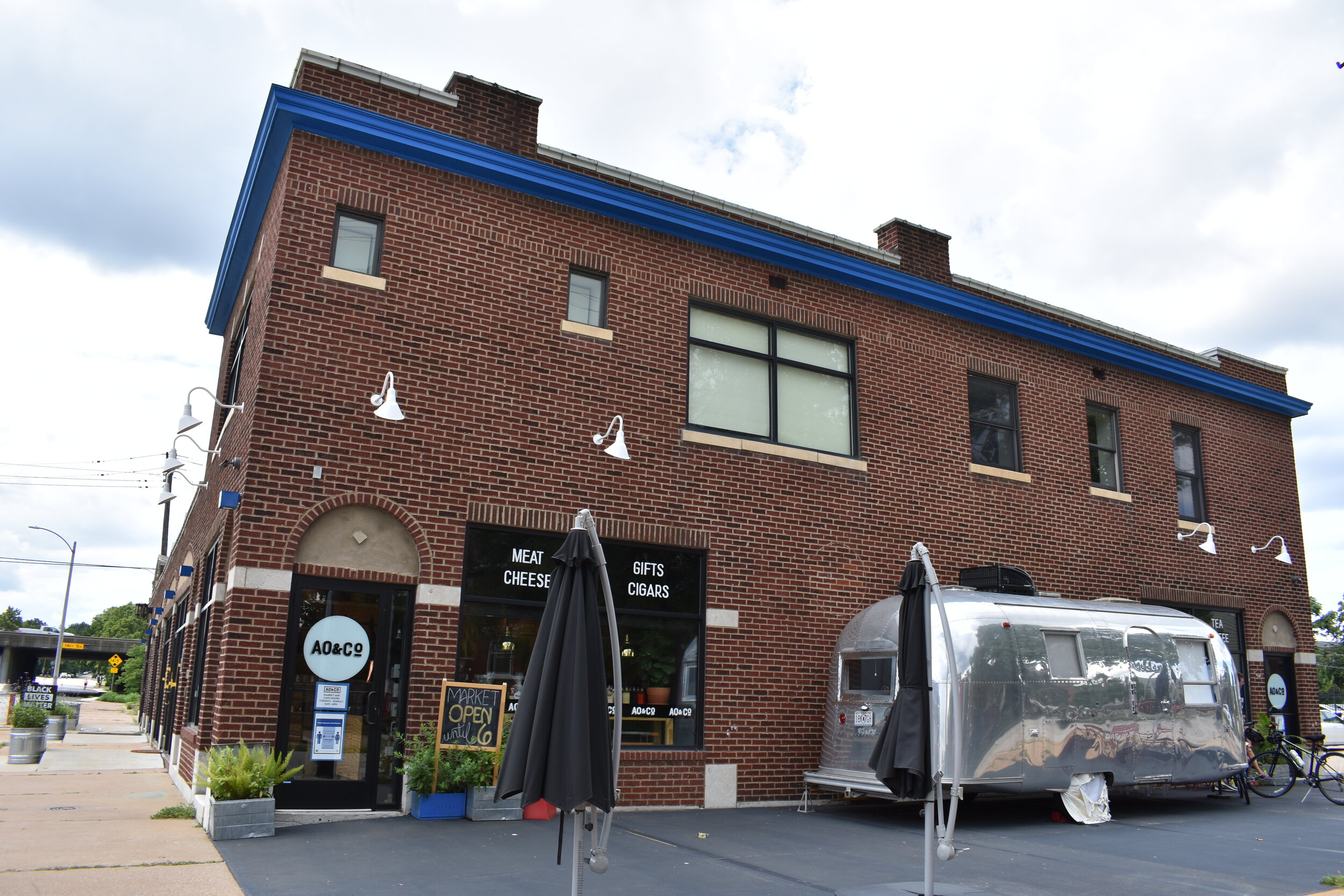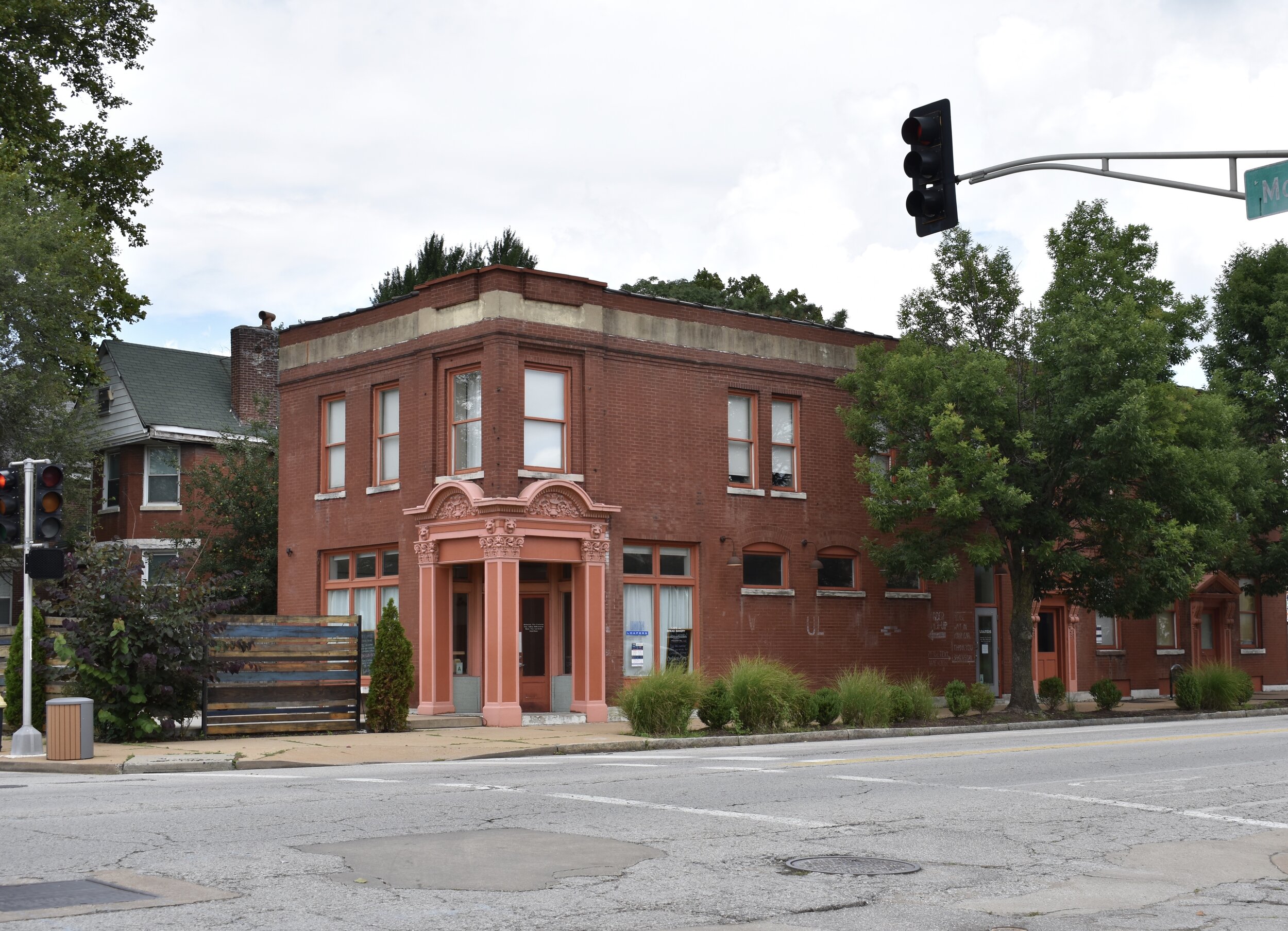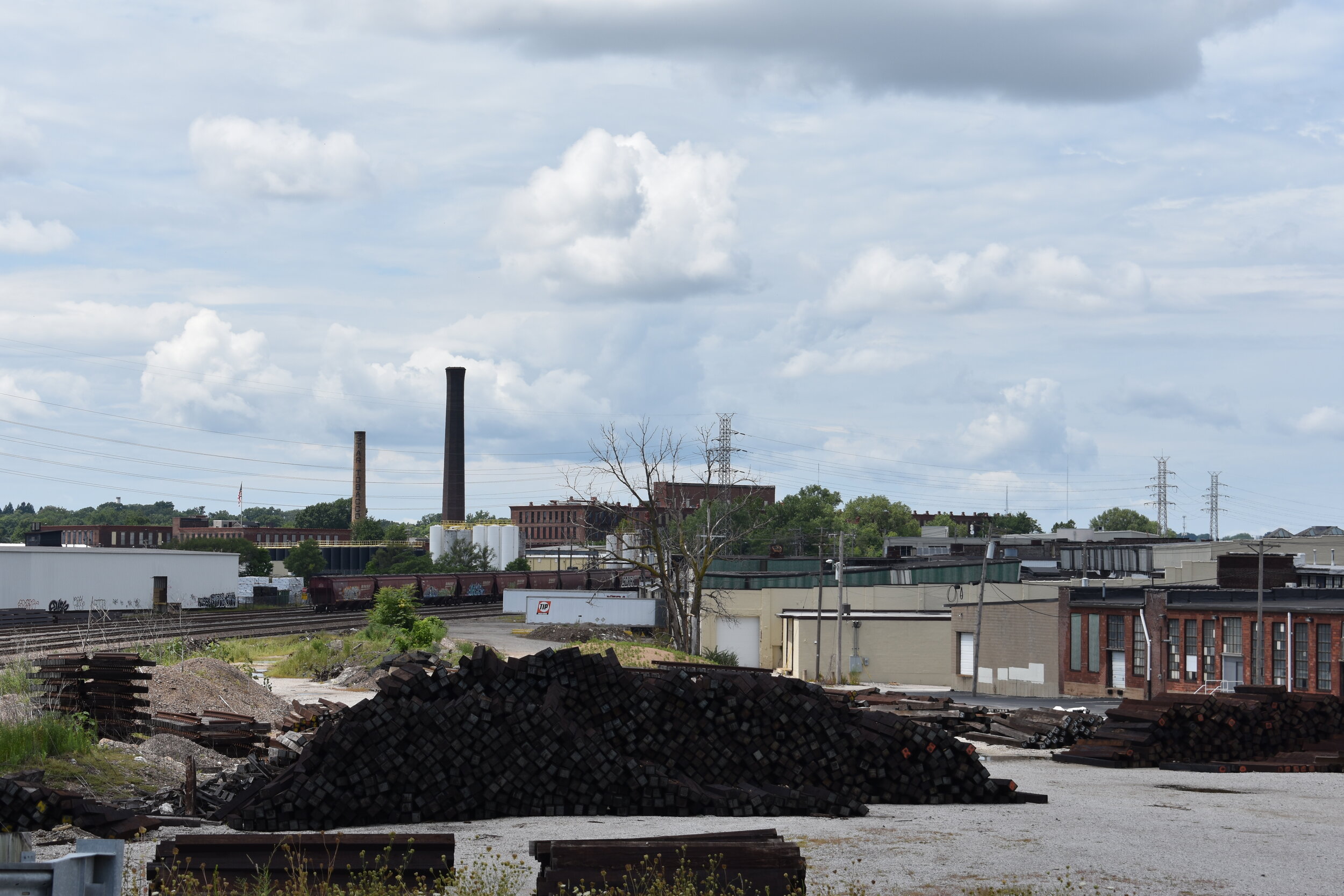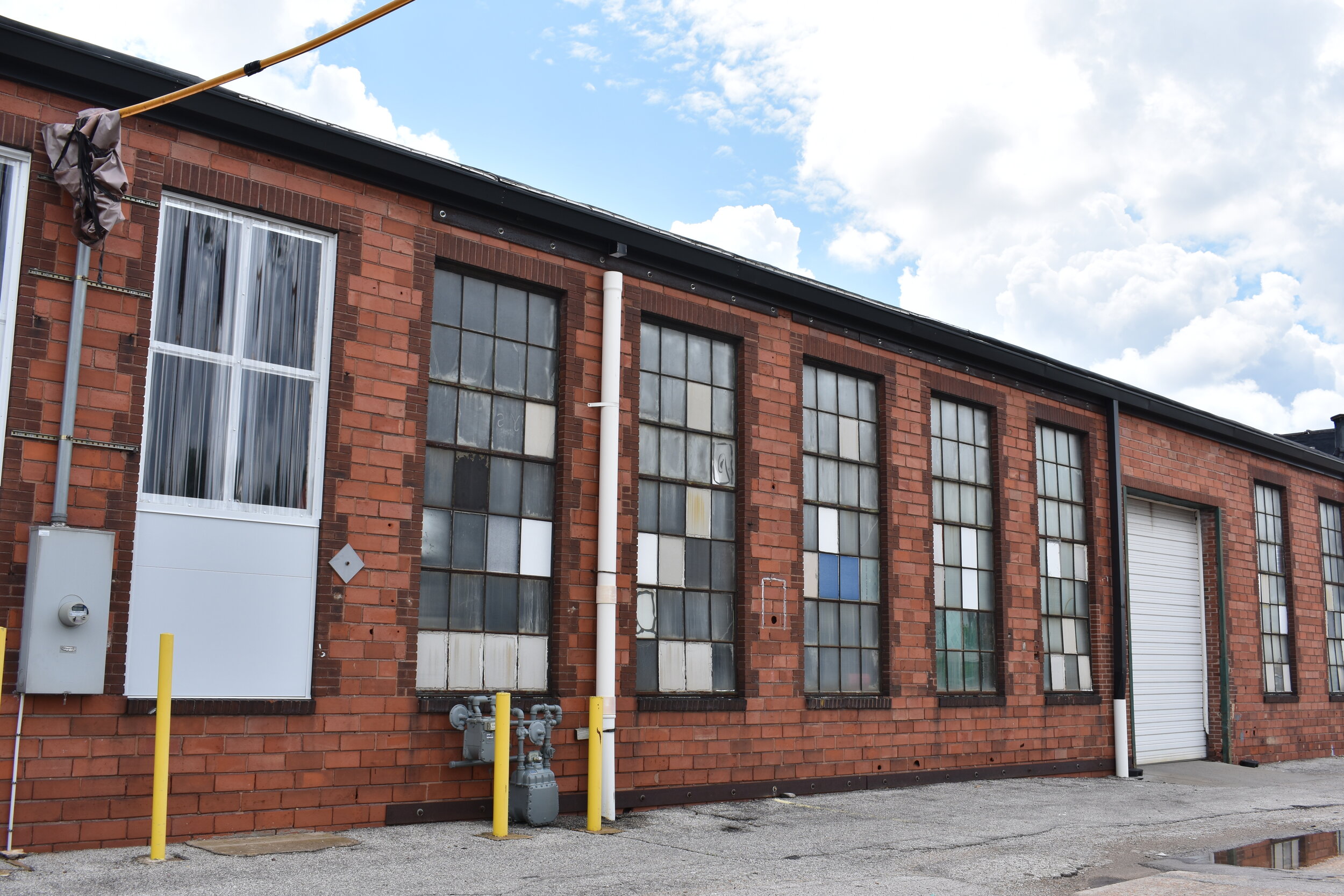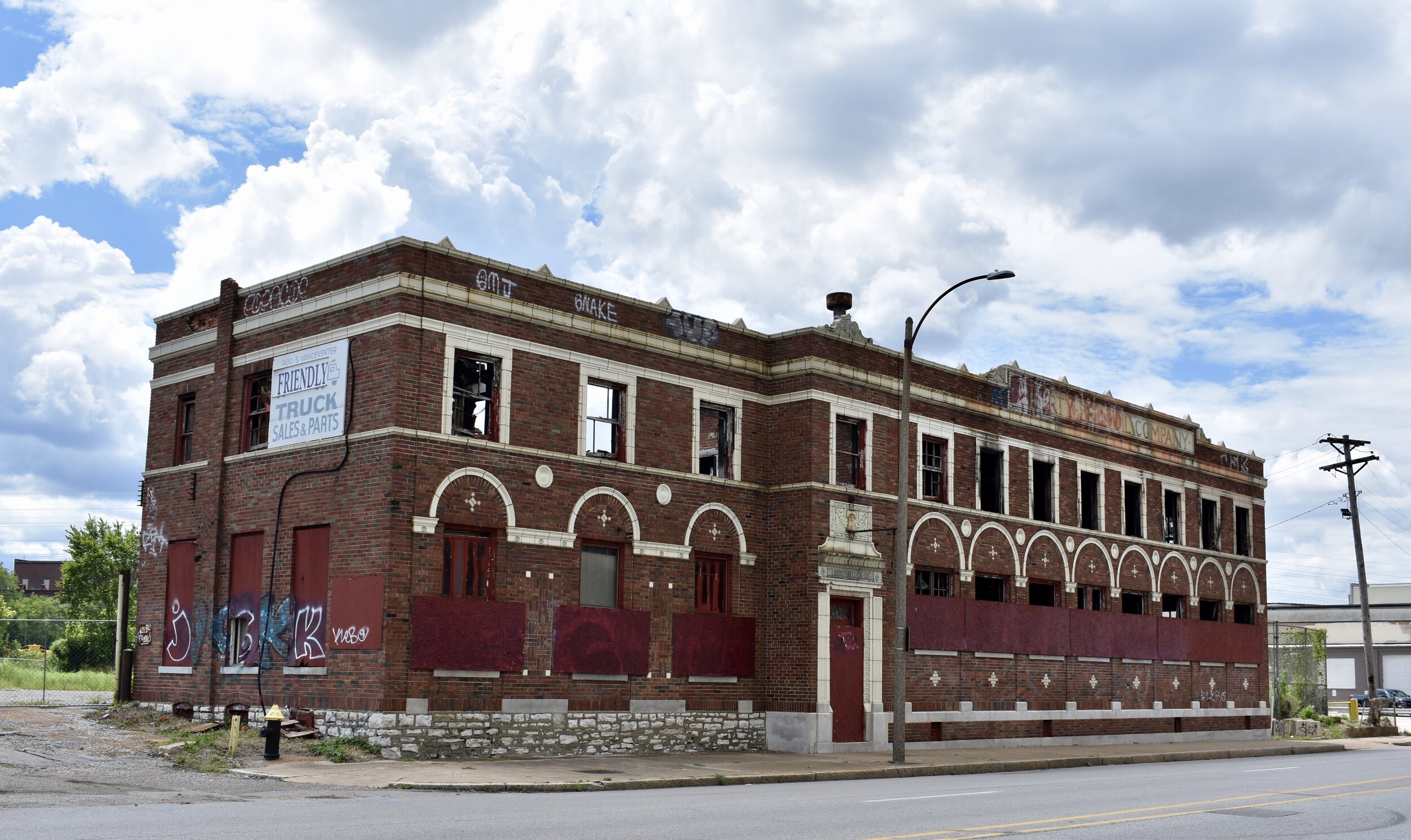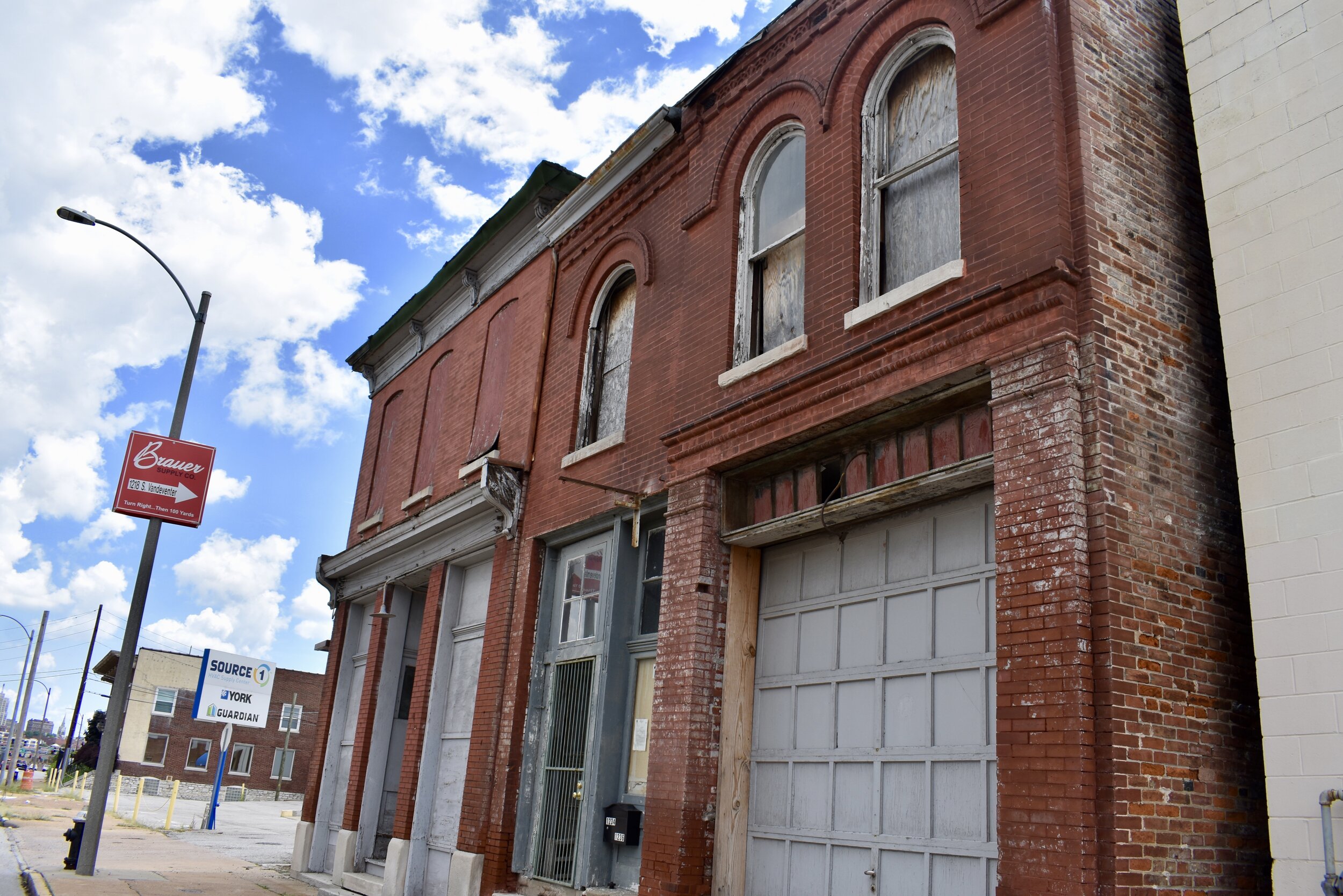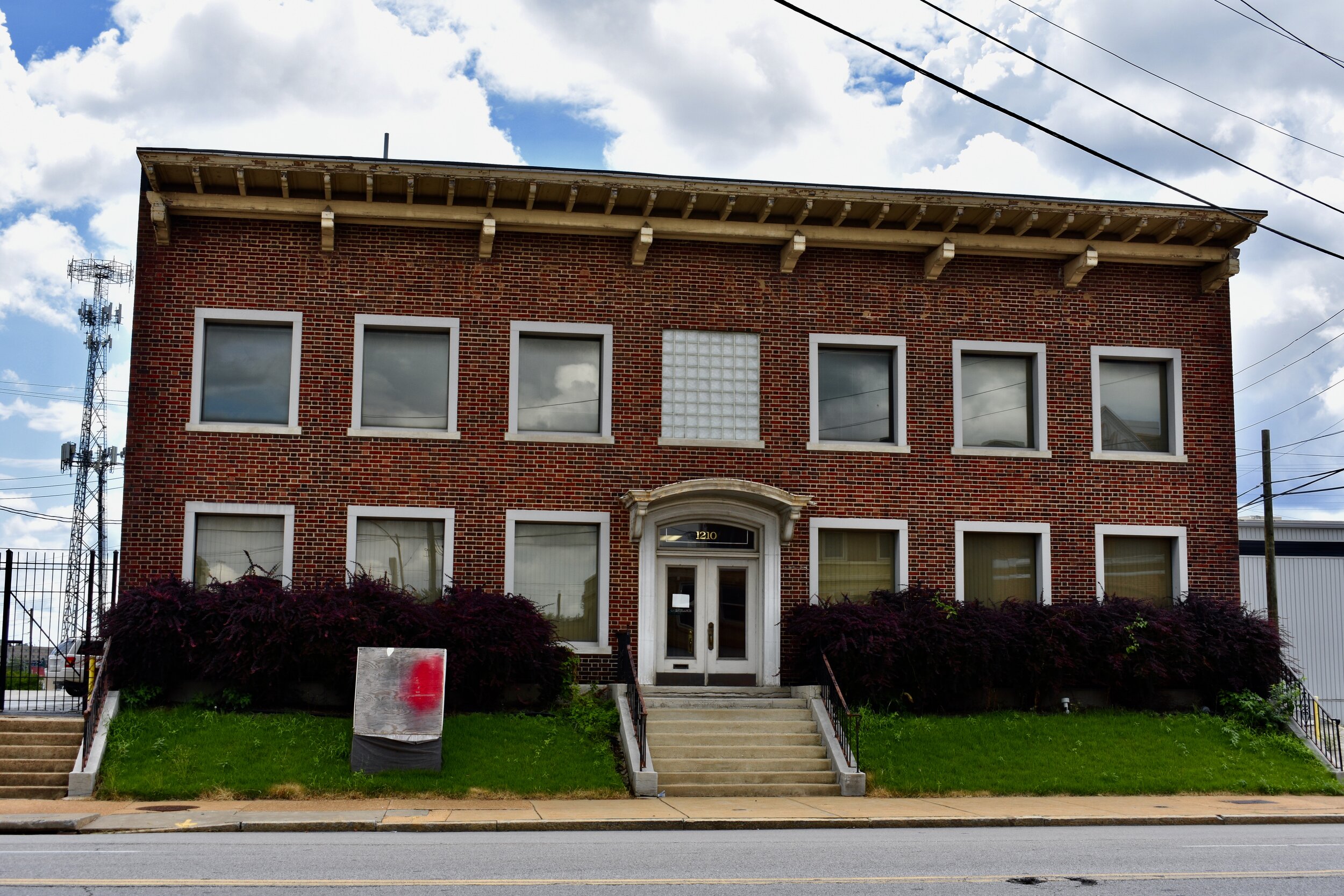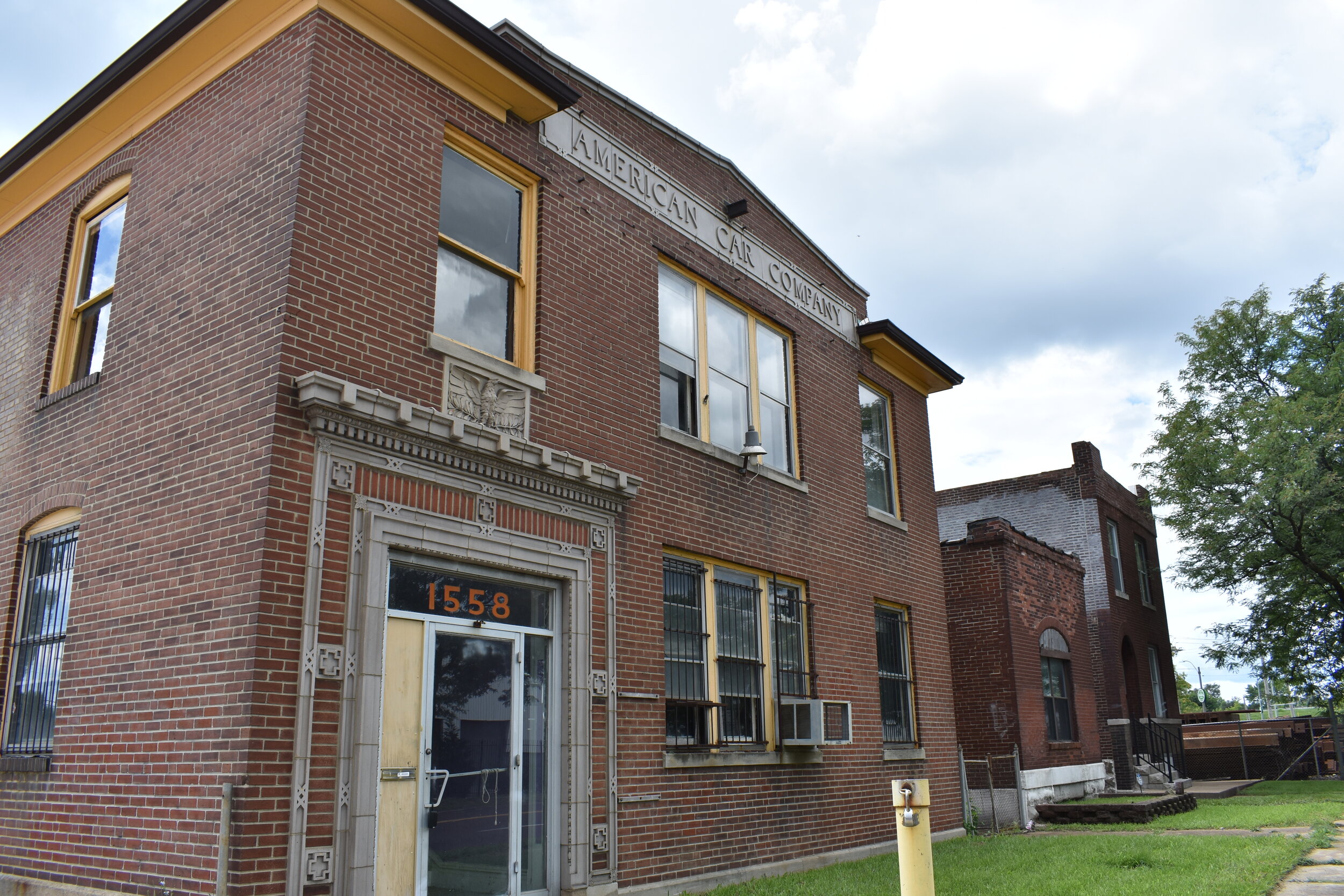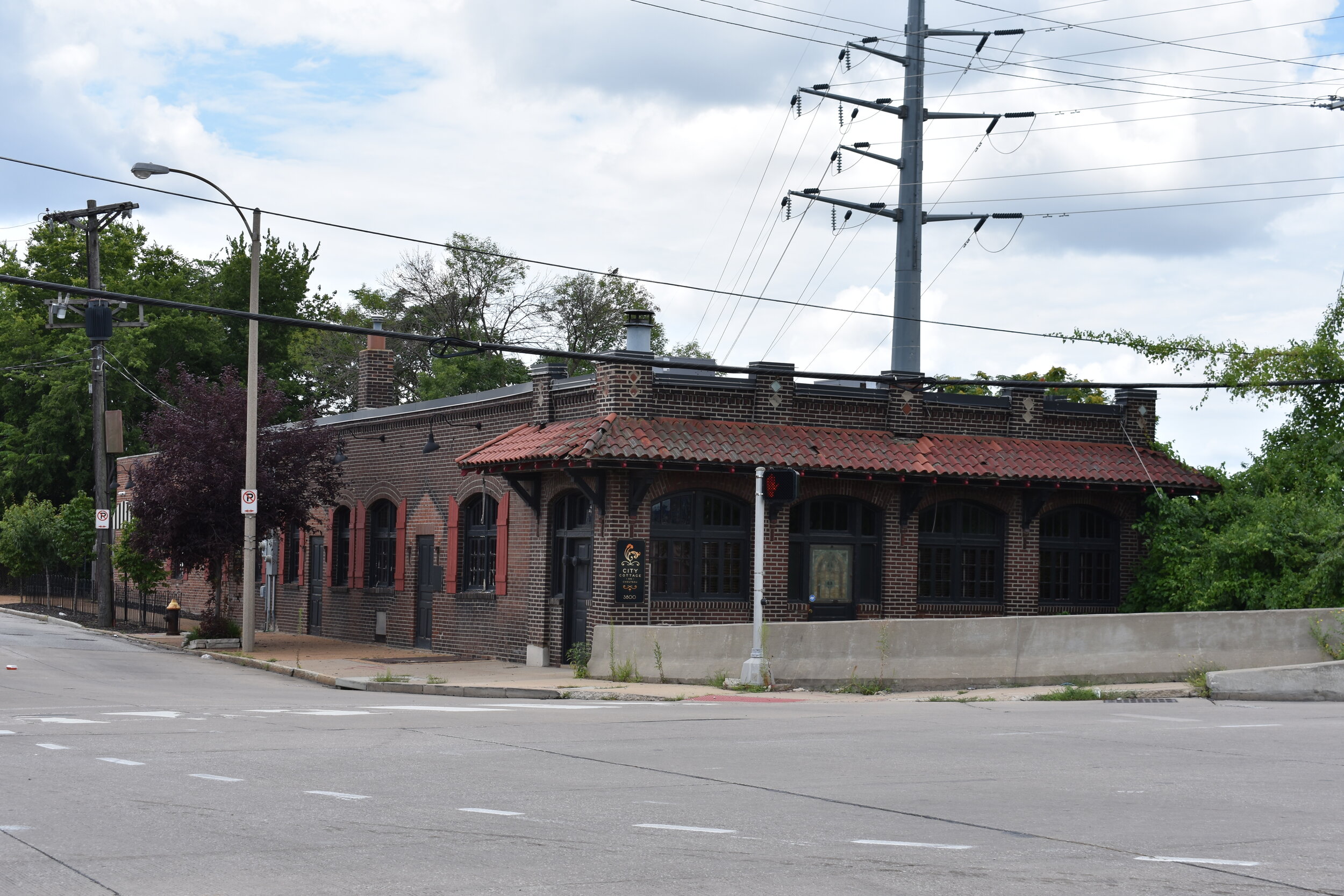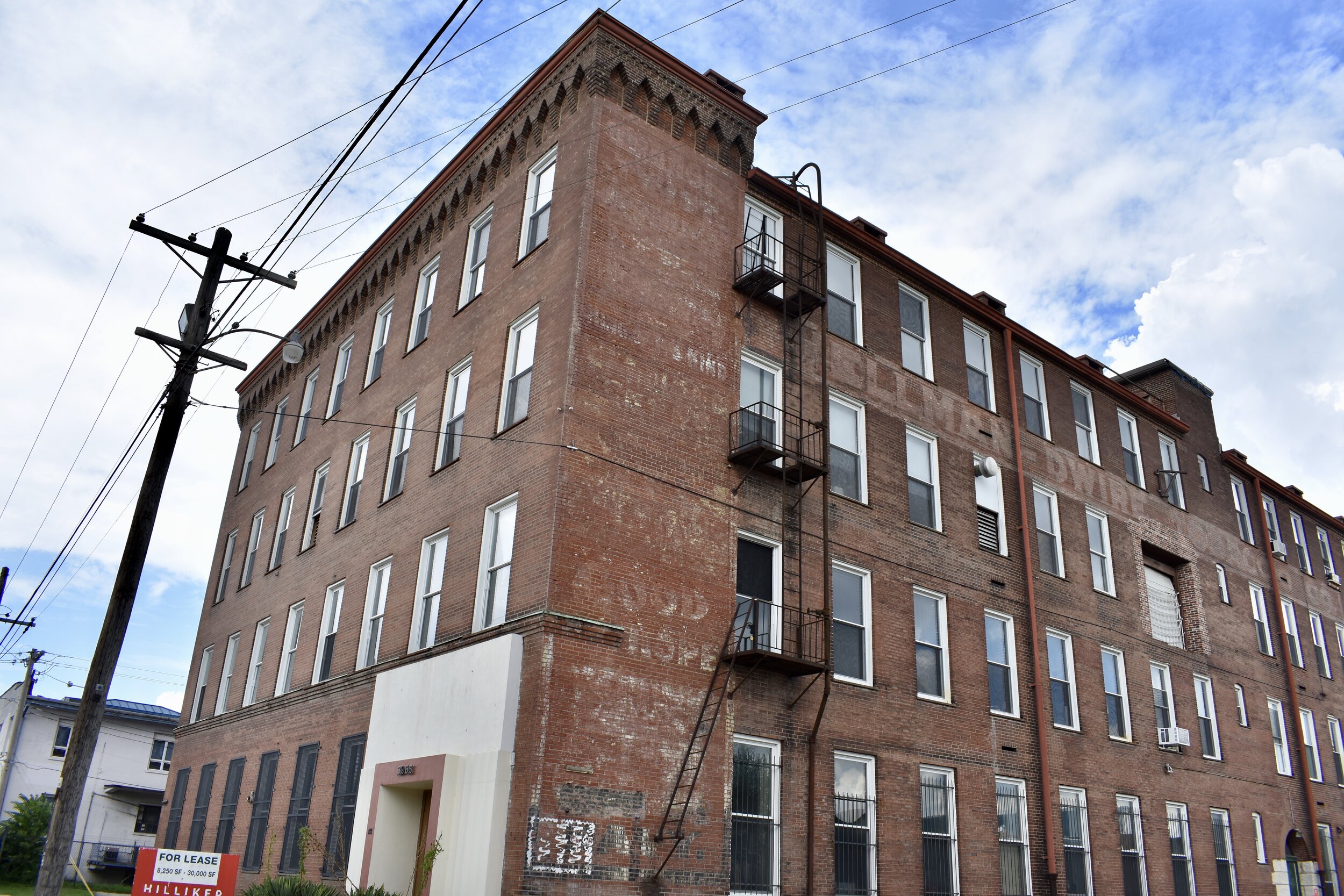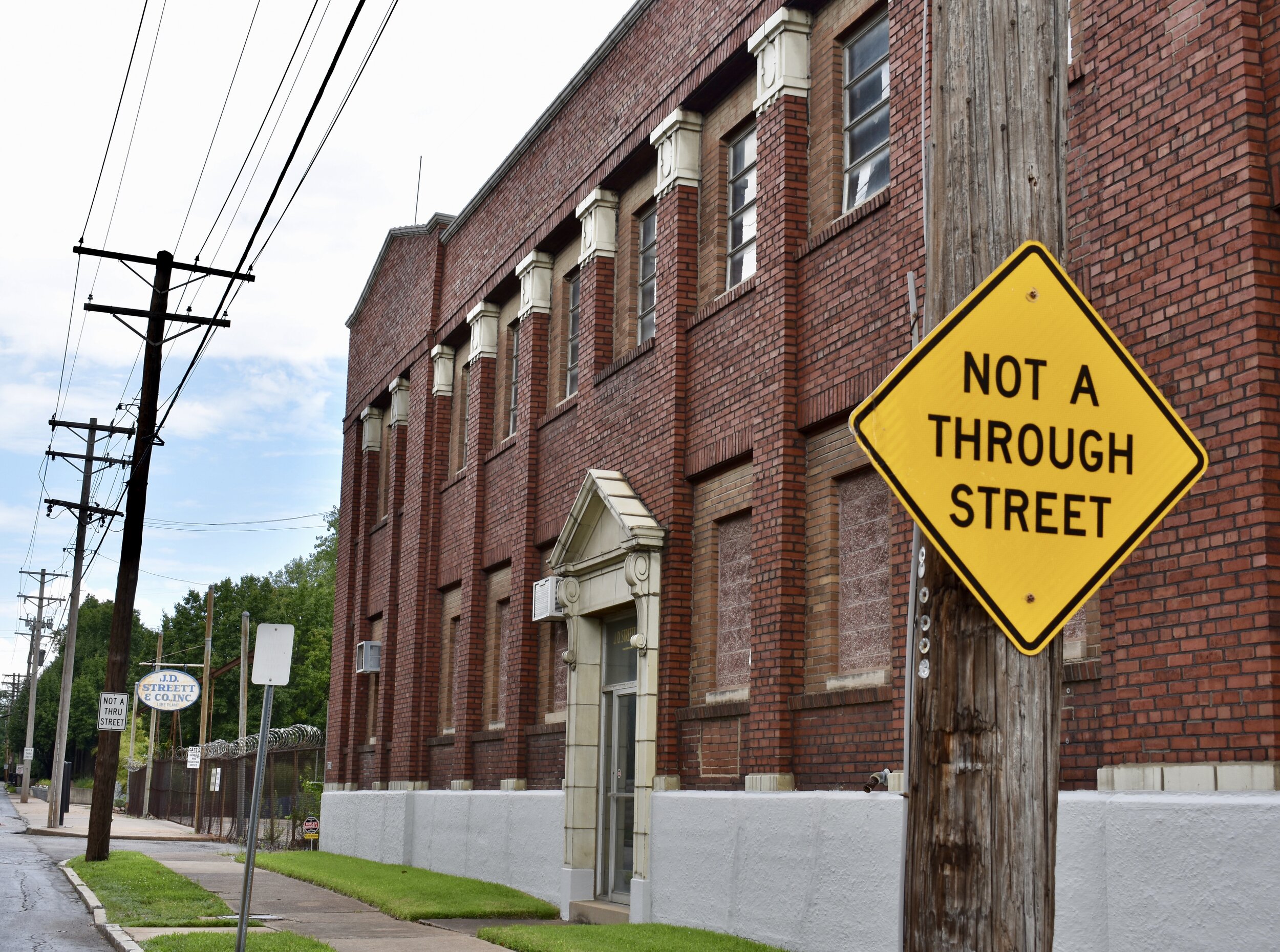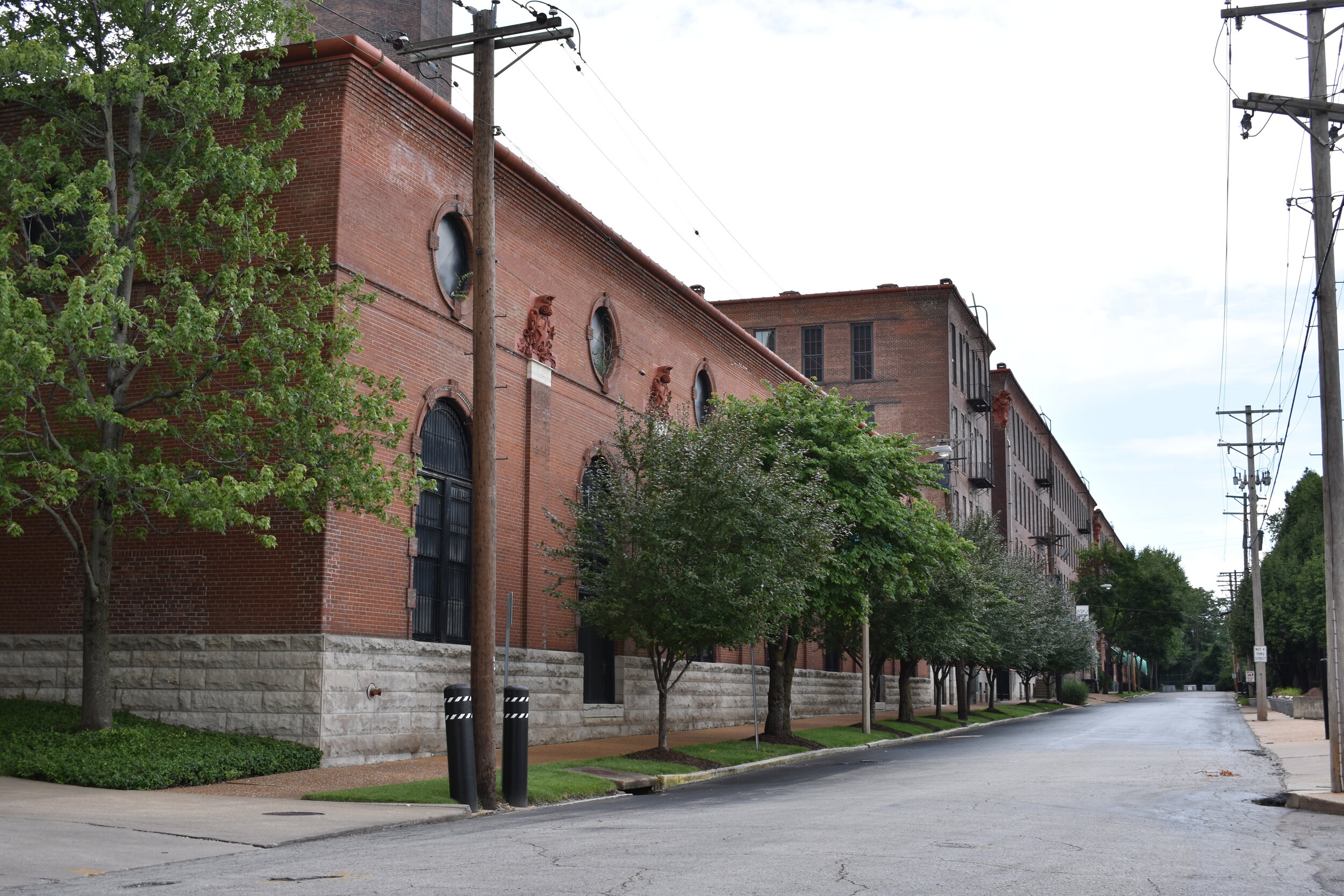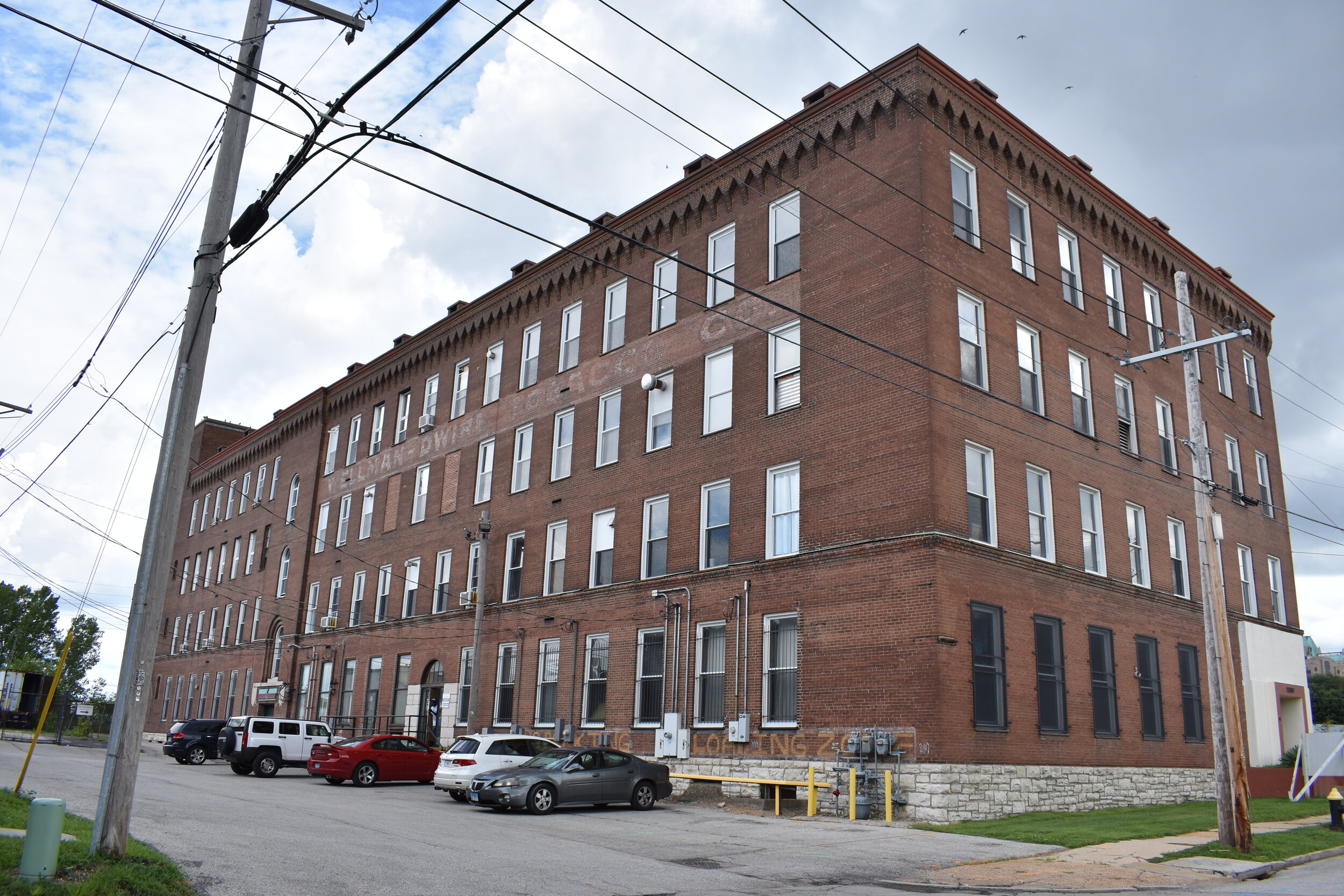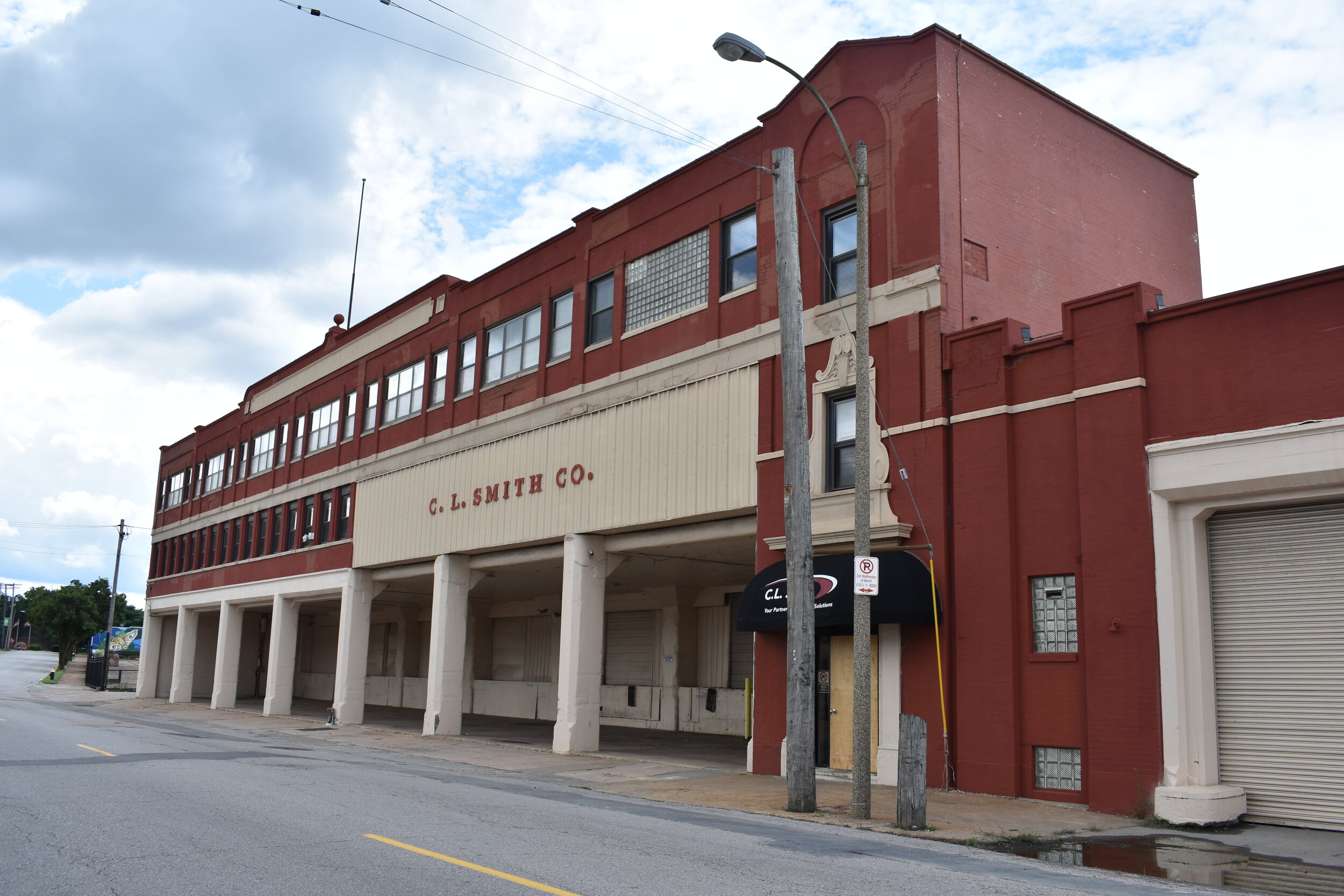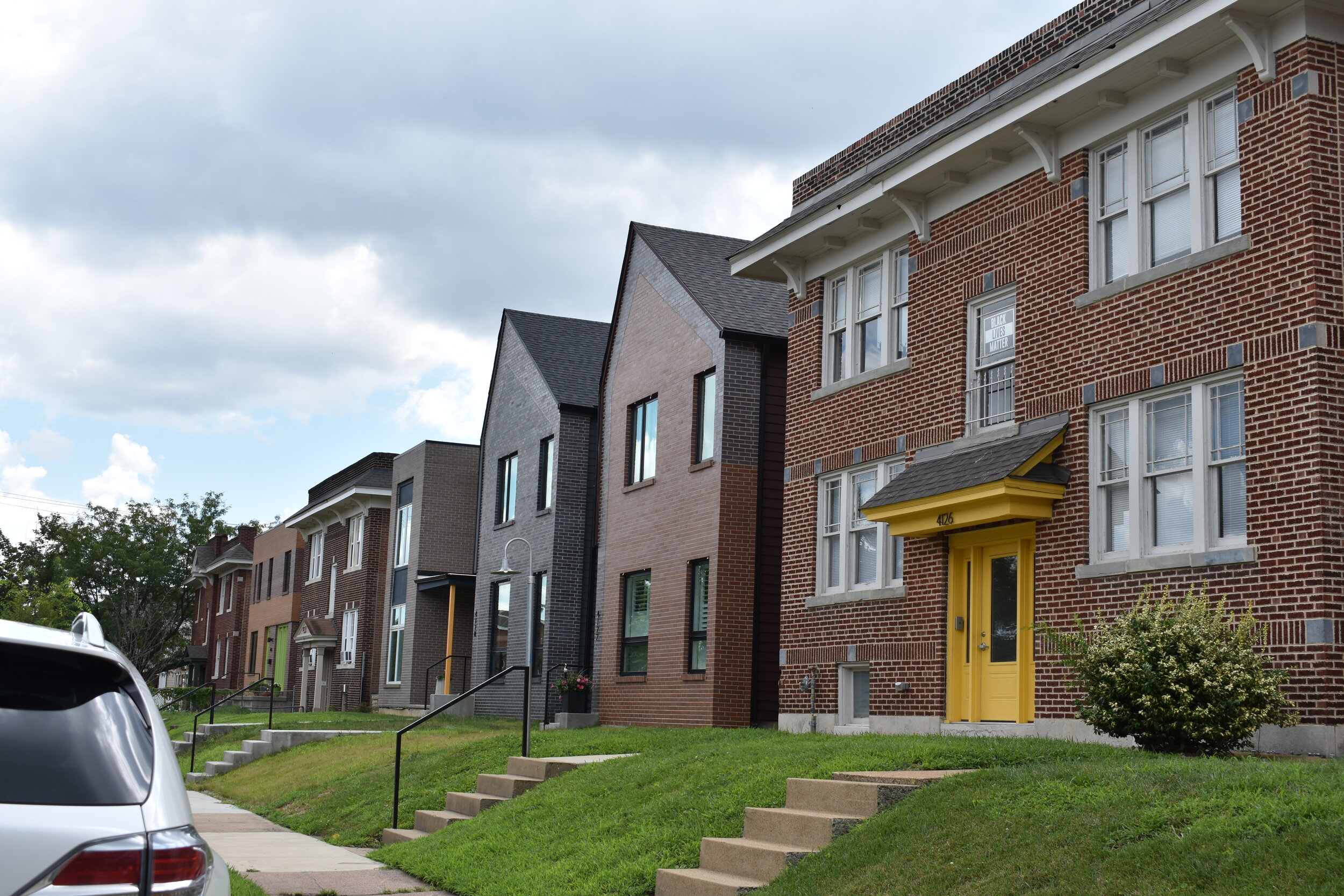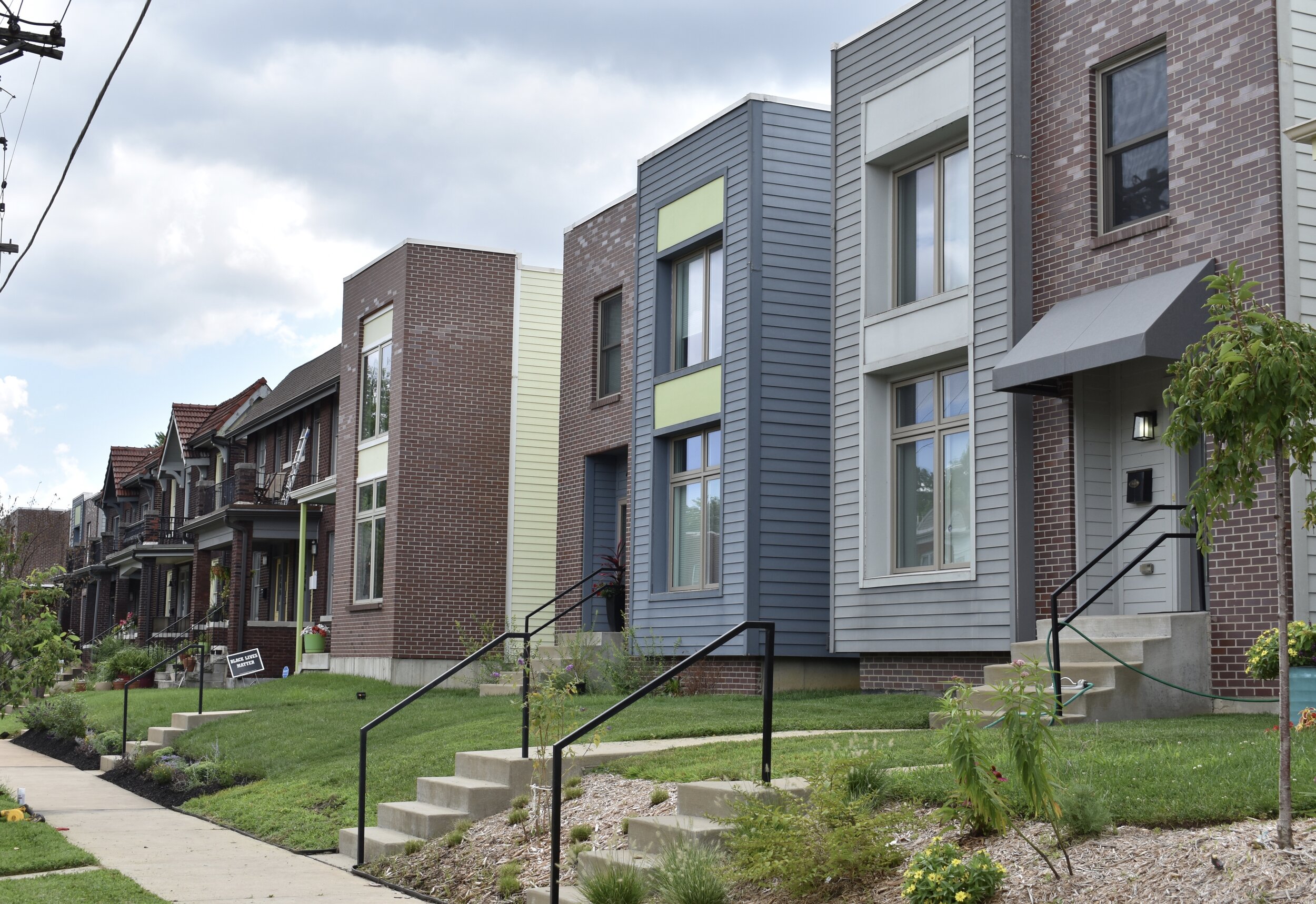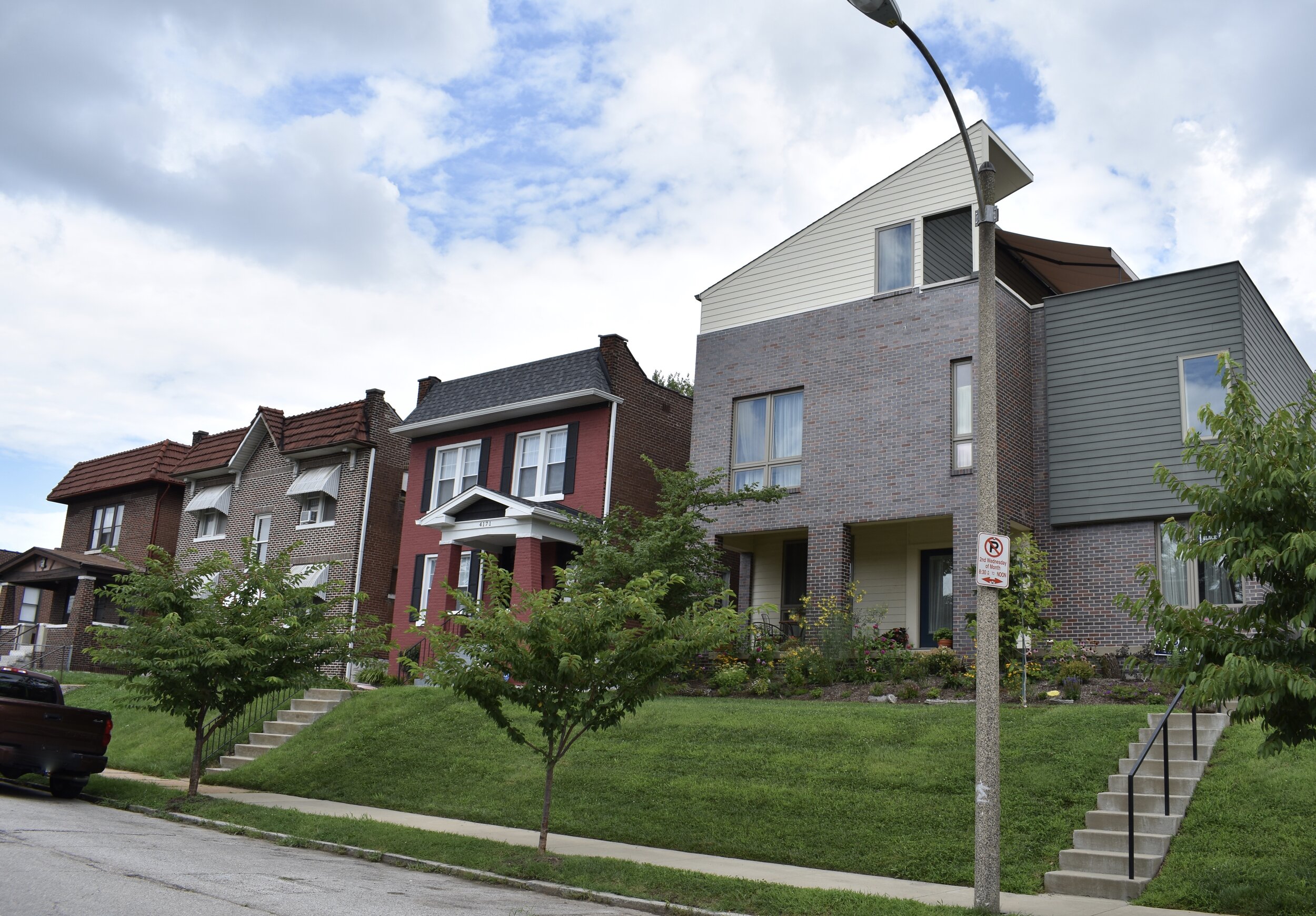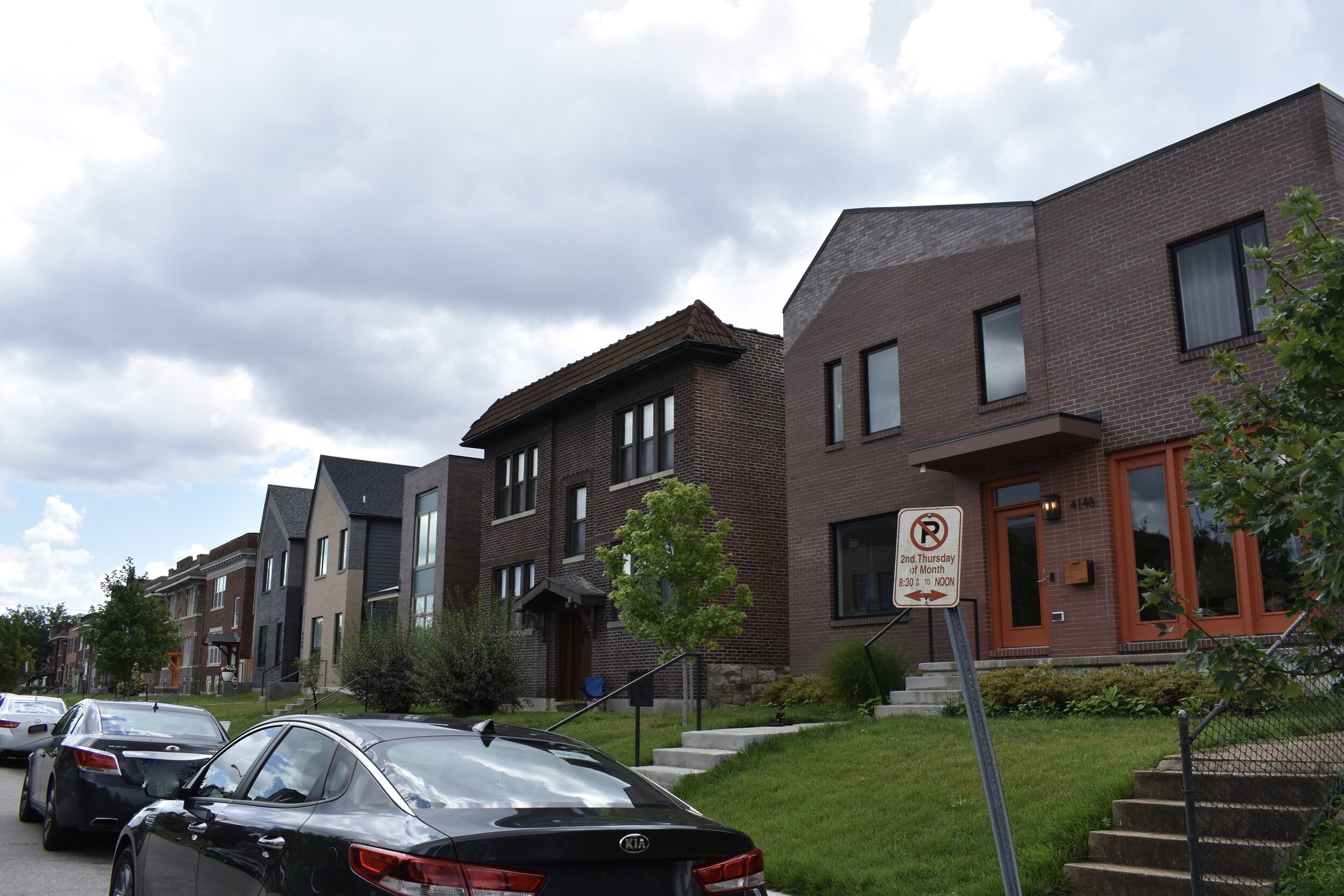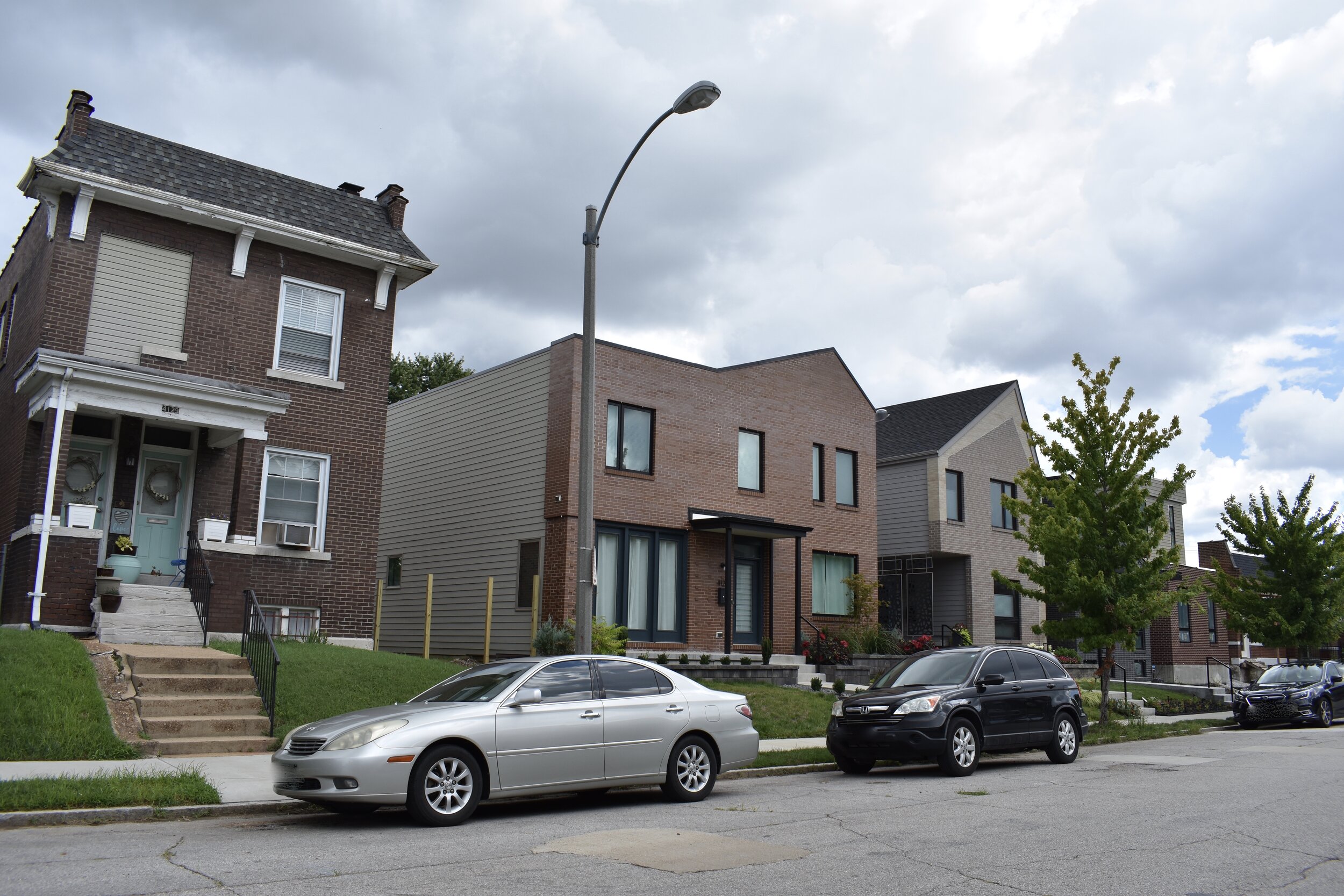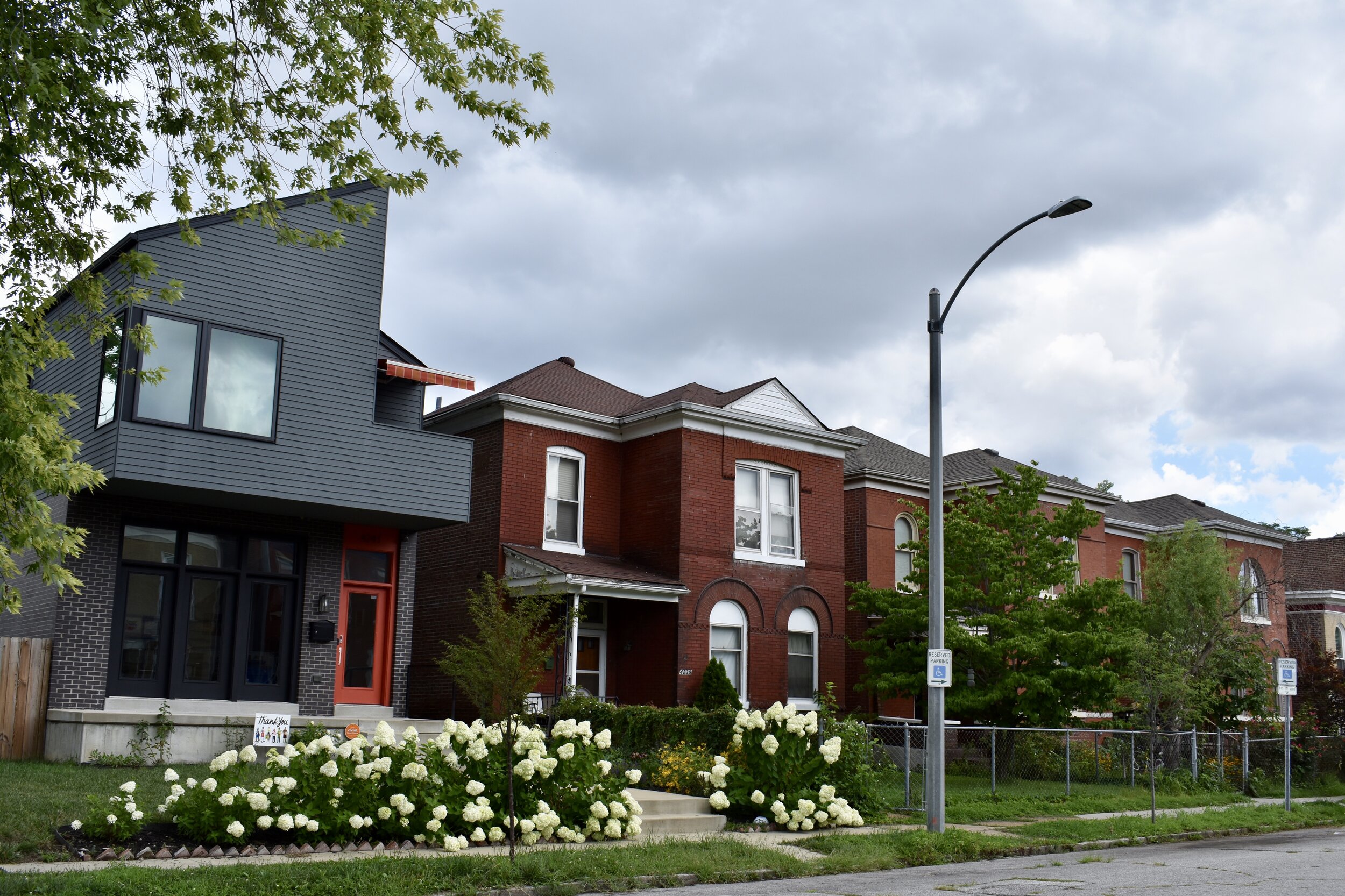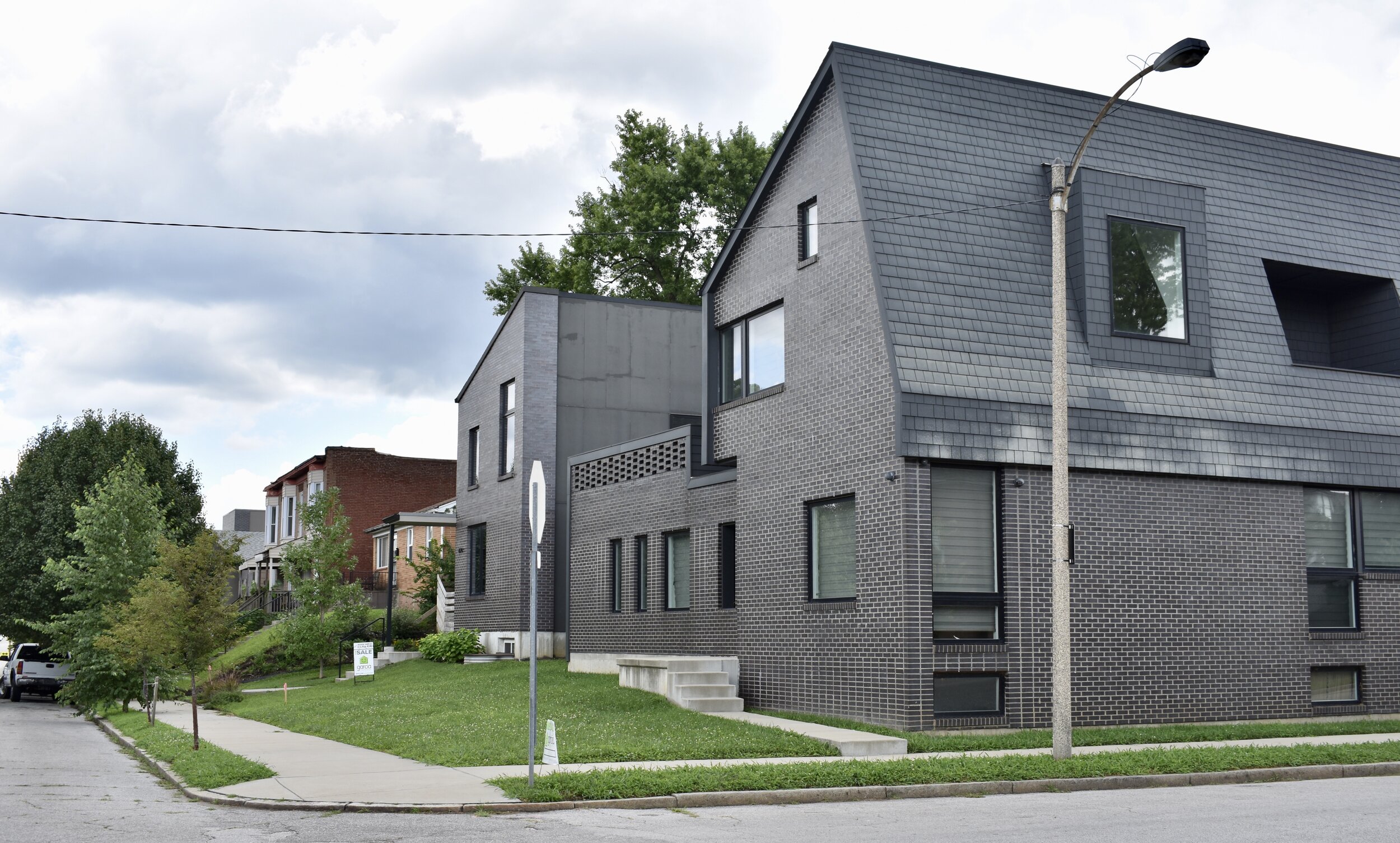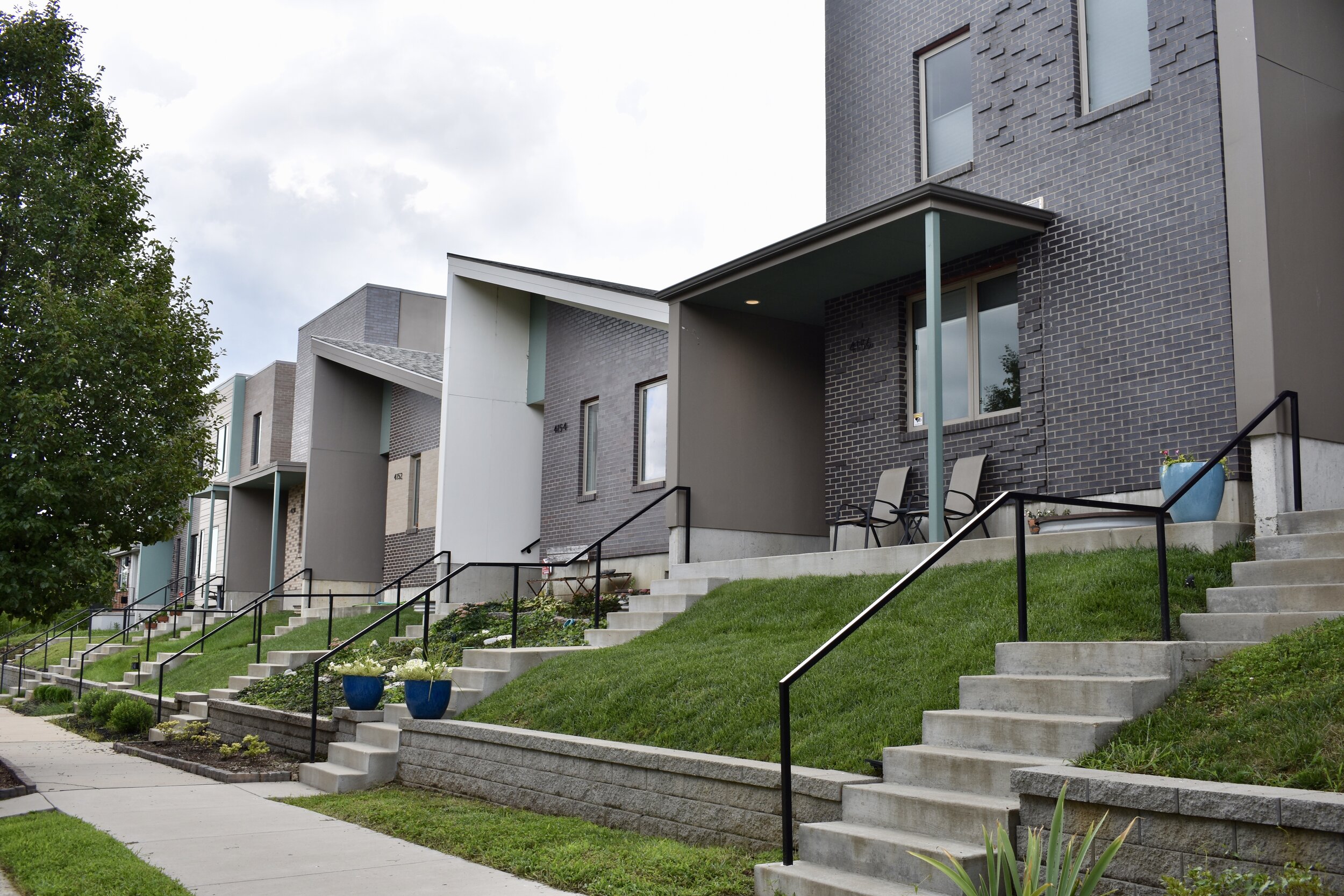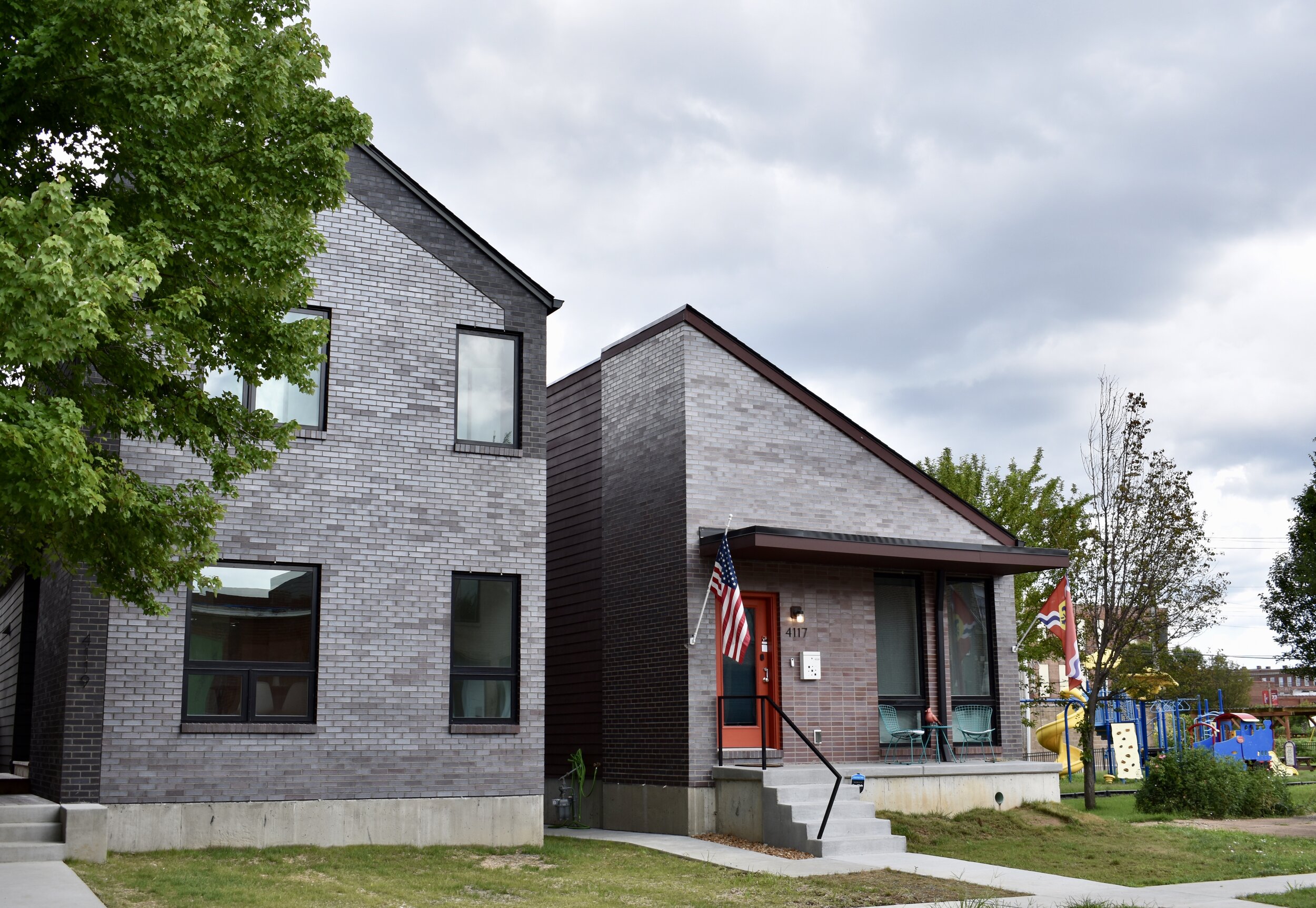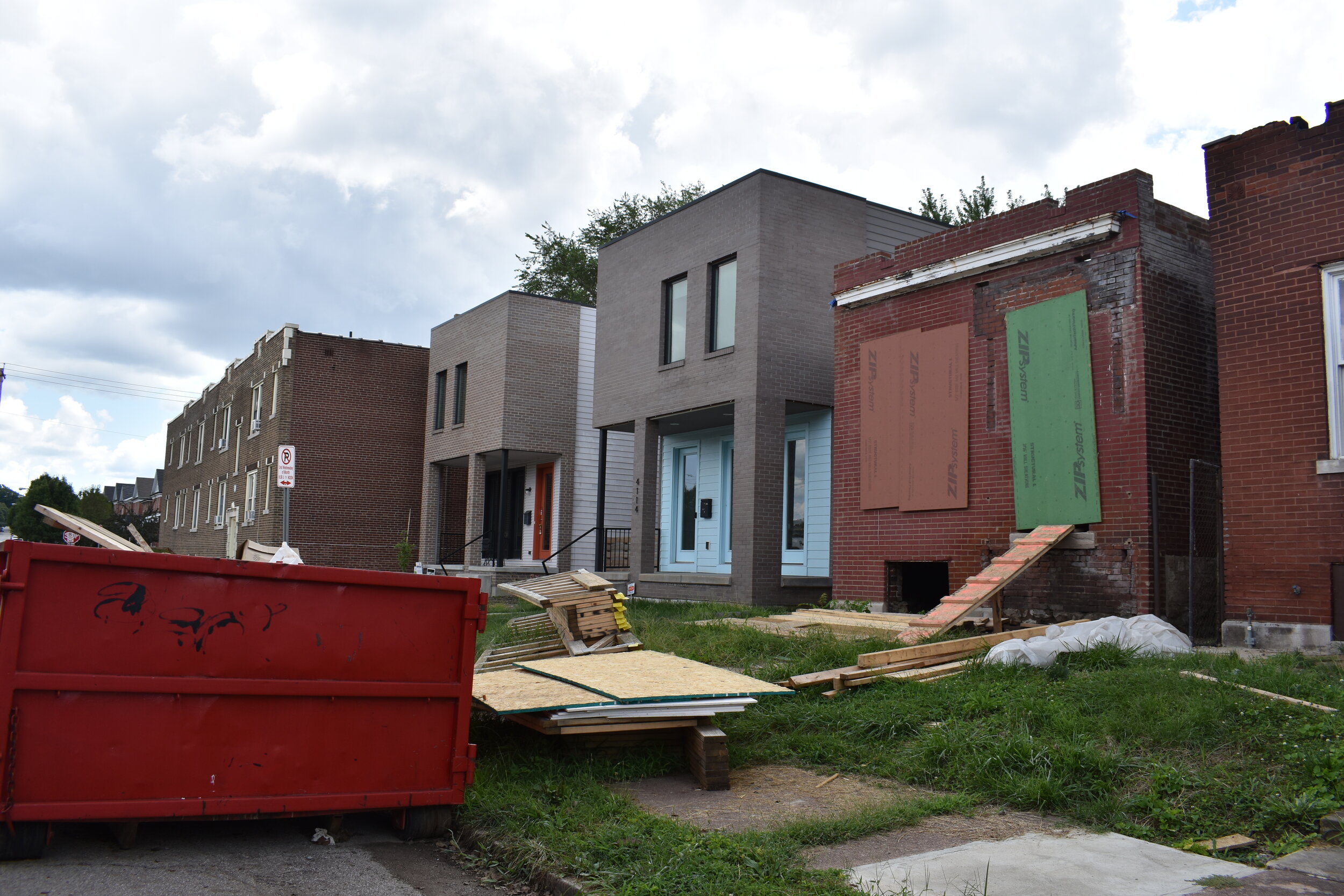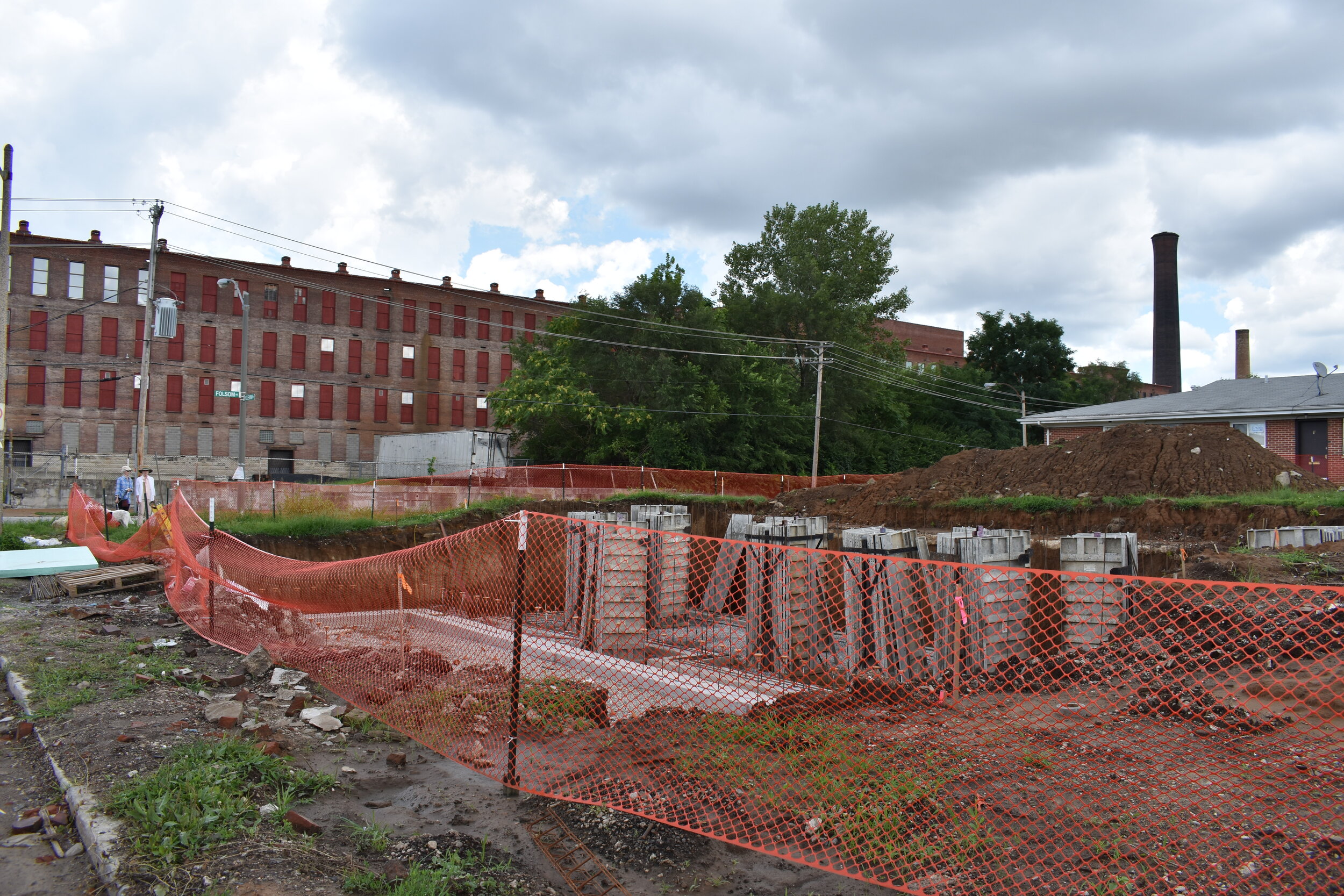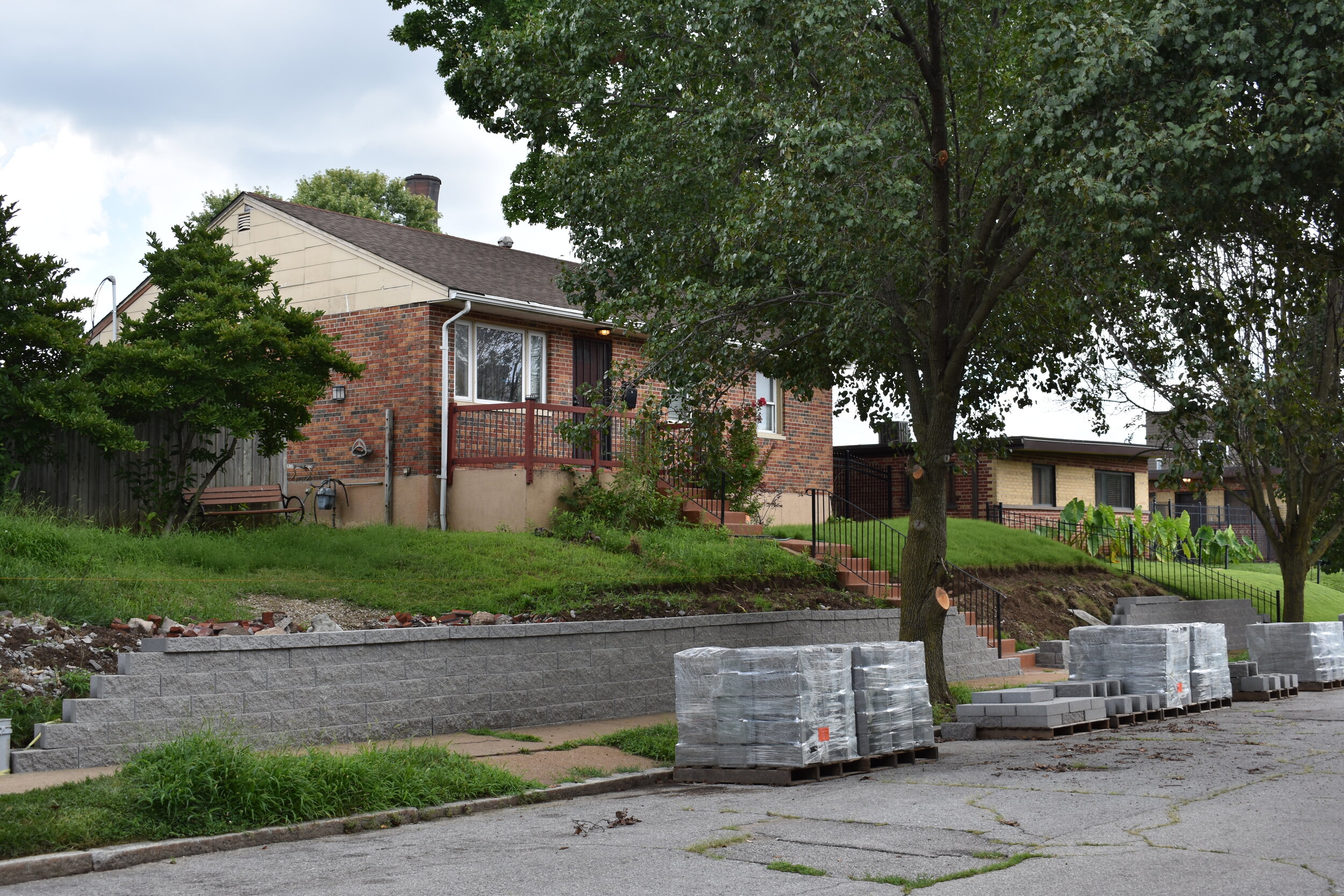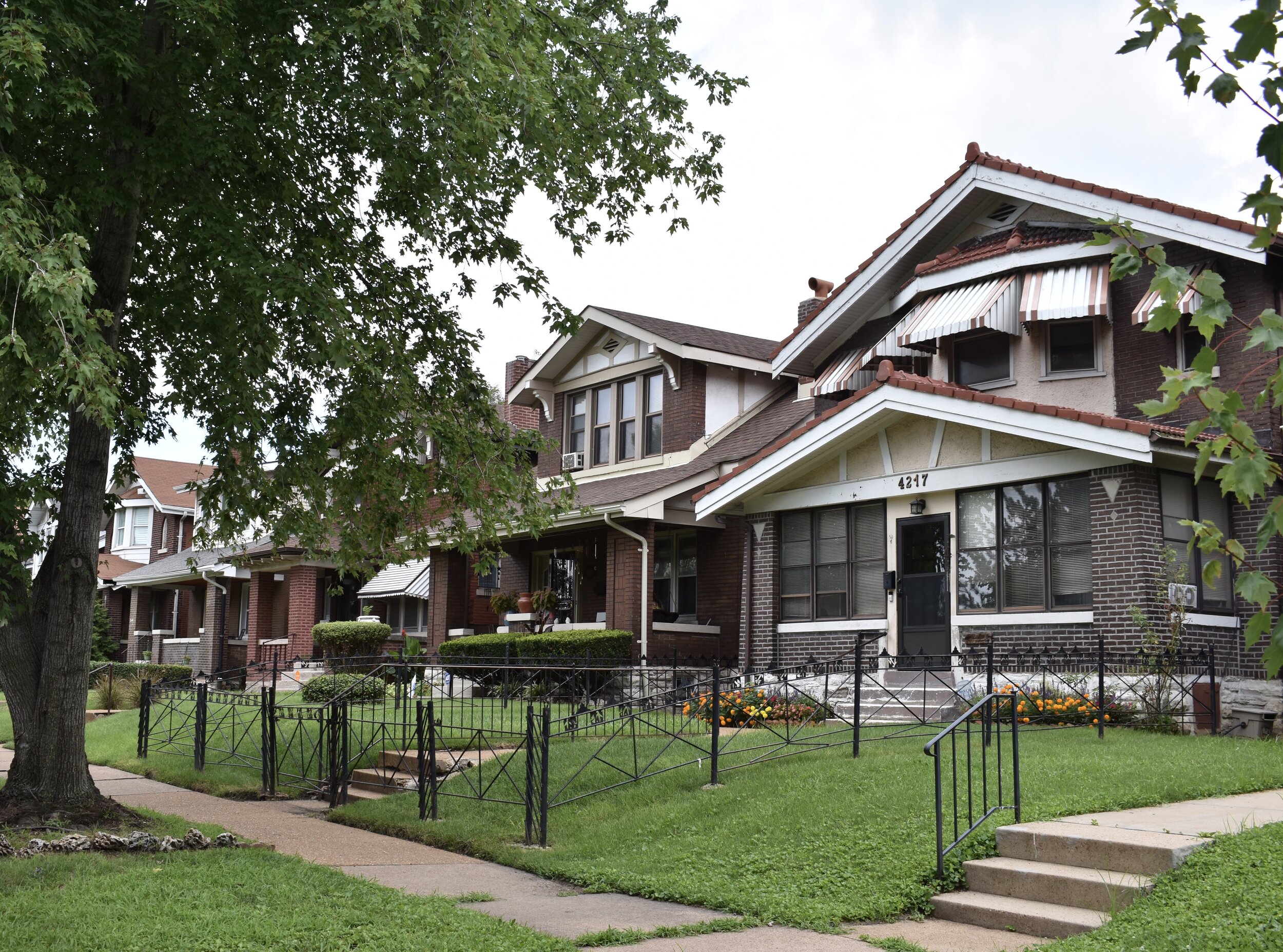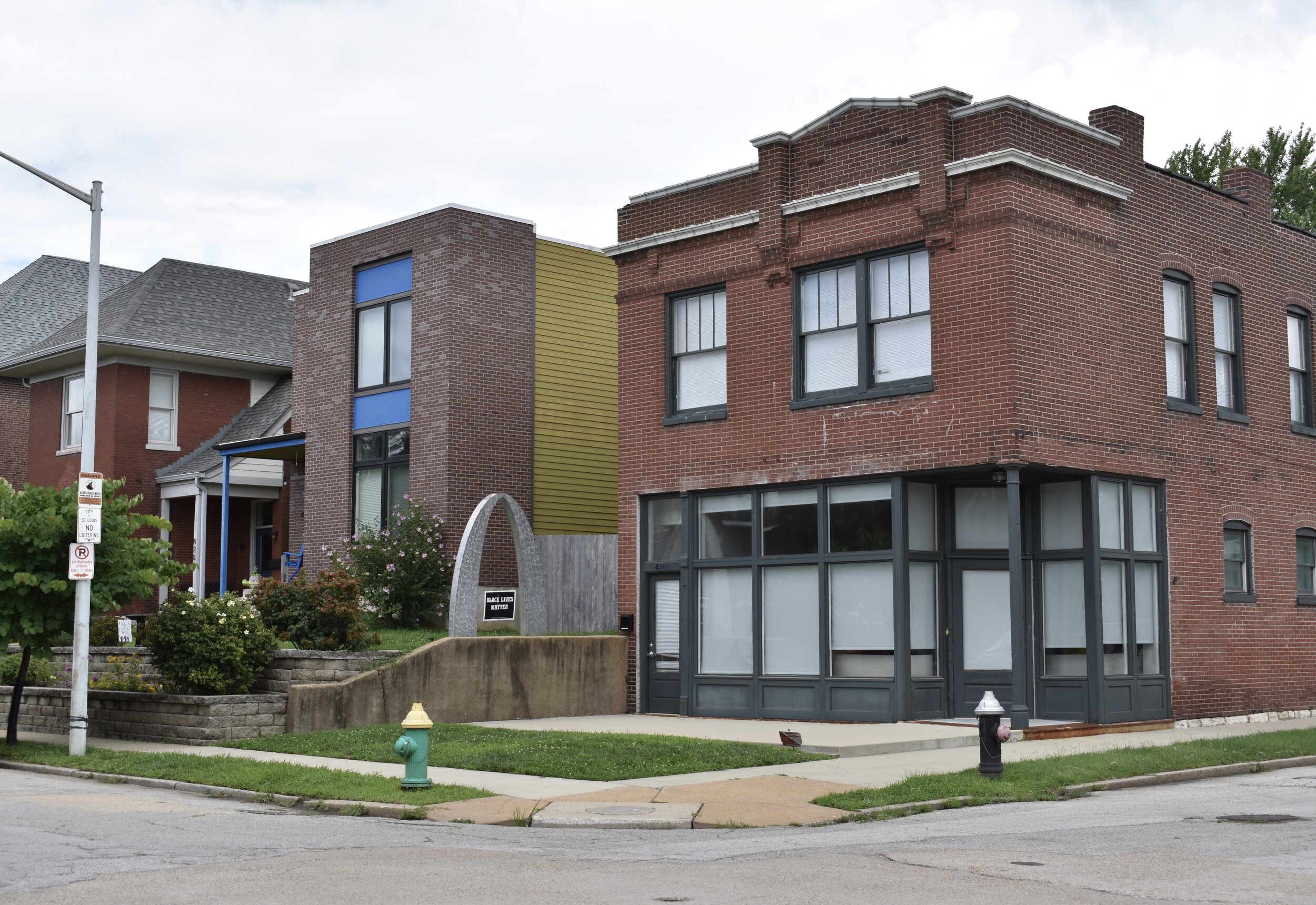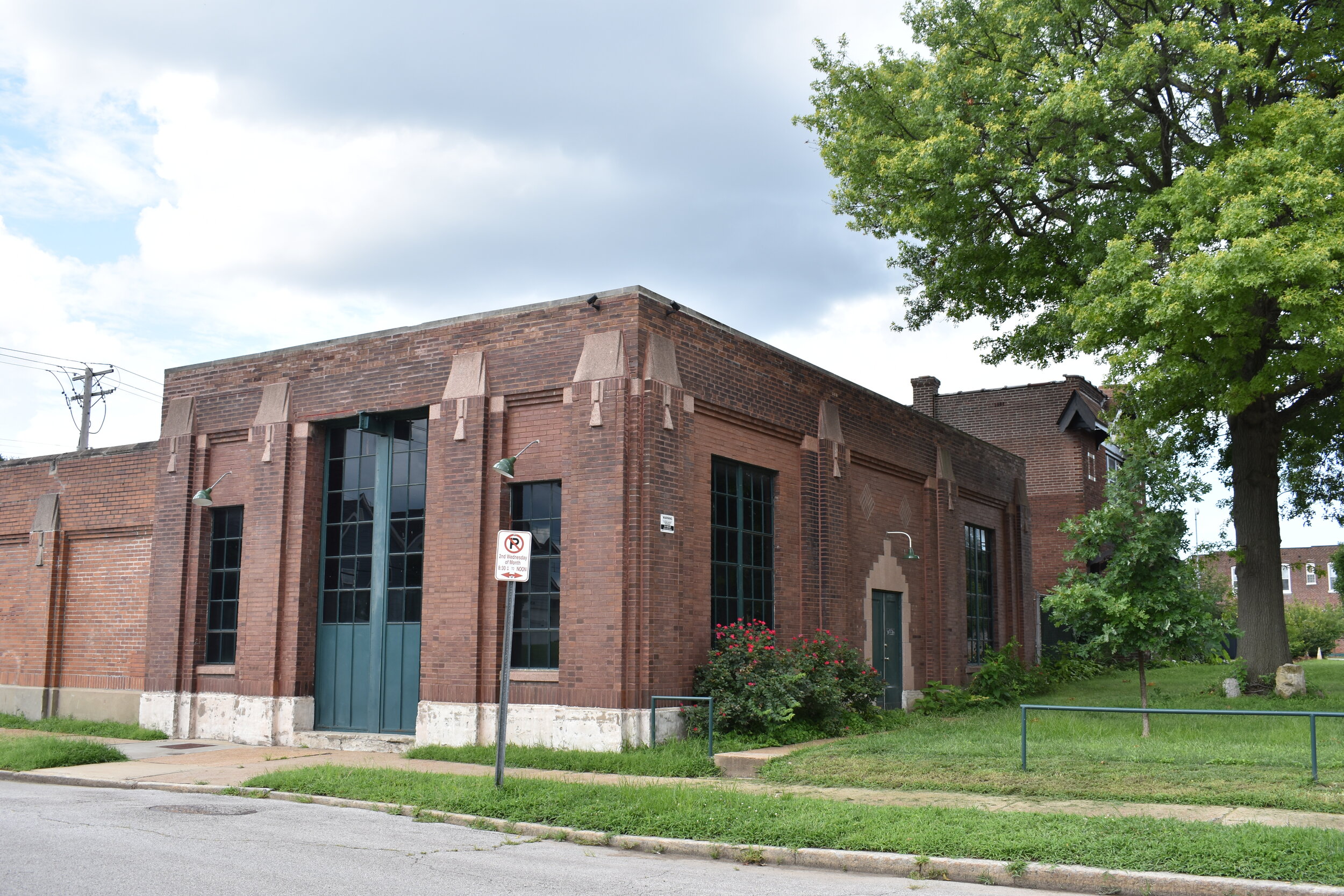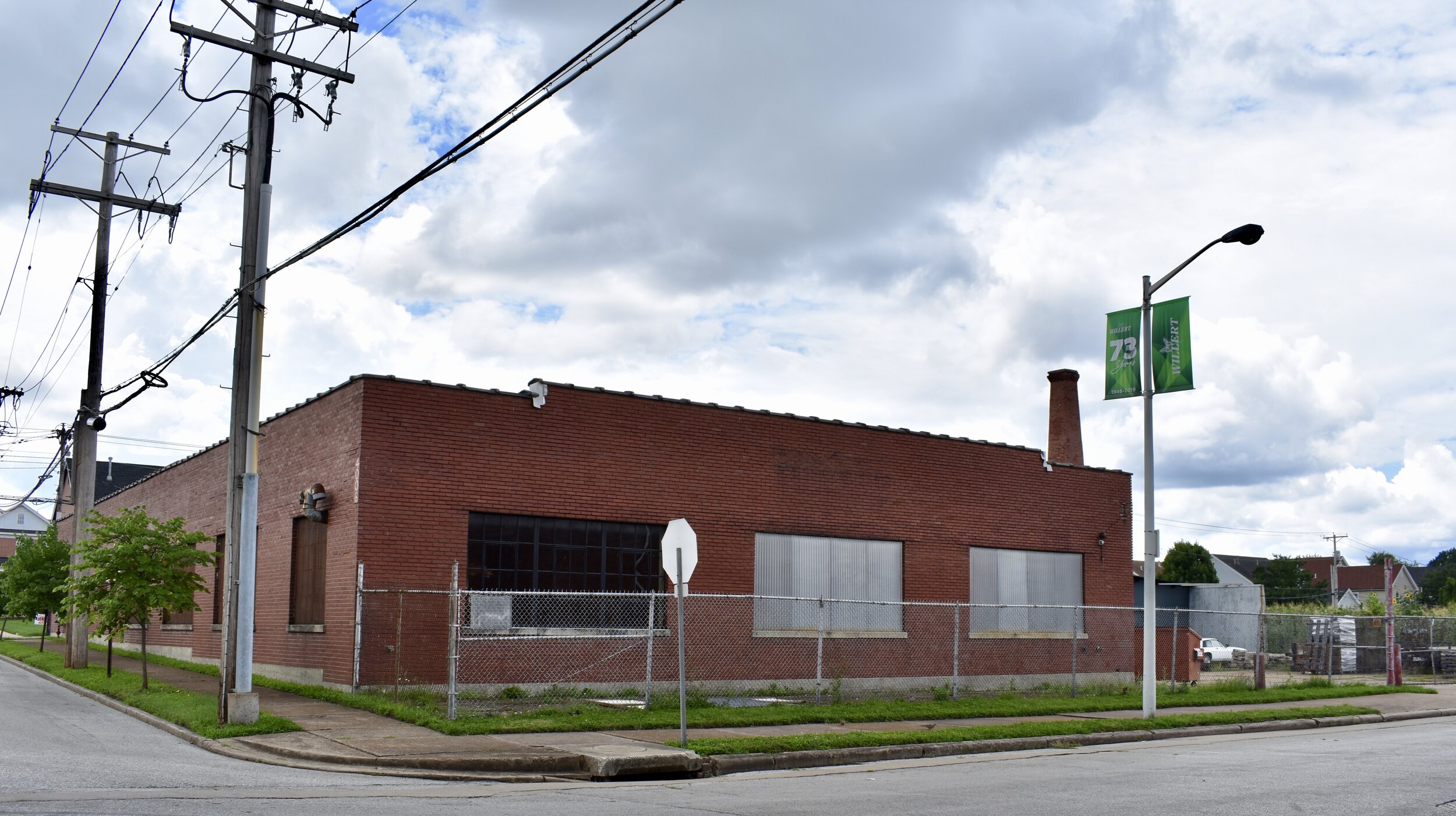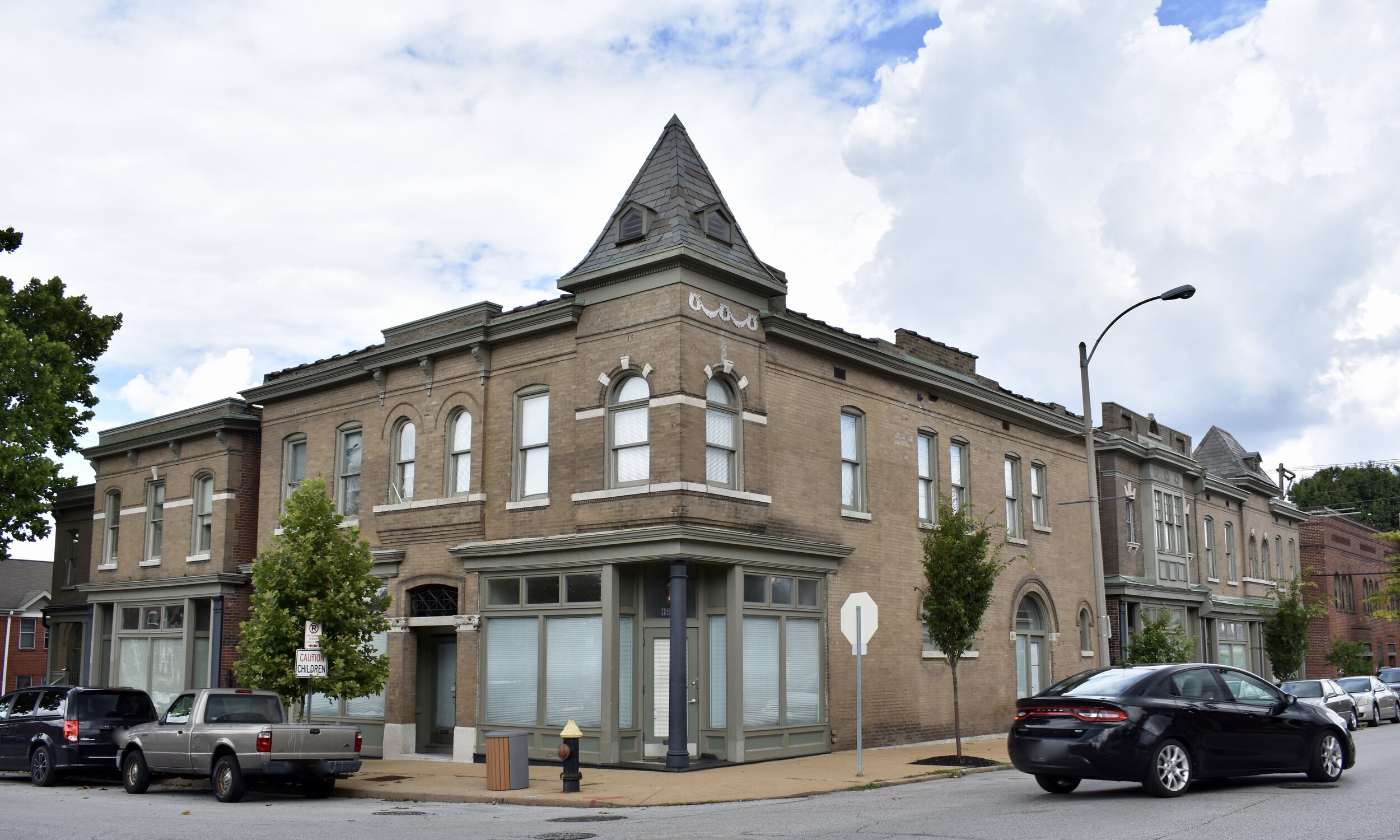Botanical Heights, formerly named McRee Town, is located south of Chouteau Avenue, north of I-44, west of 39th street and east of Vandeventer:
This neighborhood was familiar to me from driving by on I-44 for years as a kid. It was my definition of "the slums". It looked like a place where no one had any pride or hope. However, the old homes drew my attention and maybe sparked a curiosity in the formative years that helped eventually draw me to St. Louis. Since I've lived here and started paying attention to city issues, I recall that the Missouri Botanical Gardens was pivotal in erasing much of the original housing stock and history in this part of the city (McRee Town), renaming it and developing it with suburban styled new homes.
Here's a little background info from the Botanical Heights website:
"Botanical Heights is the area bounded on the west by the East side of Vandeventer curving around to the eastern boundary of 39th Street, and south to Interstate 44 at Lafayette. Developed from 1880 to 1930 as a mixed use neighborhood, we continue to be home to large distributing and manufacturing businesses, along with small businesses. Since 2004 Botanical Heights has been populated with nearly 150 newly constructed single family homes and townhomes constructed by McBride and Sons Homes. Additionally, there are a number of historic home rehabilitation projects underway in the neighborhood as well. As residents we appreciate our multi-cultural community, and its close proximity to bus lines, Metrolink and Interstate 44. Missouri Botanical Garden, Tower Grove Park and Cardinal Glennon Hospital are all part of our community. Other amenities include quick and easy accessibility to Downtown St. Louis, St. Louis University and its hospital, and the cultural resources of Grand Center."
Now let's take a look at who lives here. From the 2000 census data: the total population was 1818 people, that's a 31% decline from 1990. In 2000, 88% of the population was black, 6% white, 2% American Indian, 2% Hispanic/Latino, 1% Asian, 1% Pacific Islander. Another massive decline was estimated in the 2010 census count. 781 people packed it up and left...43%. It appears Botanical Heights has hit rock bottom. It can only get better, right?
More from the 2000 Census data: of the 539 households in Botanical Heights, 80% were 2 or more/household, 90% of those were family households. Of those 72% were unmarried, 85% of which were female with no male.
And the housing stock in 2000: 65% occupied, 35% unoccupied. Of the 65% occupied, 78% was rental property.
2020 Census data saw a 13% gain in residents with some significant racial shifts to 50% Black, 37% white, 7% more than 2 races, 5% Hispanic/Latino and 3% Asian. 50 housing units were added and occupancy is 85%.
So there's some stats, history and background information on Botanical Heights, now let's take a look at what this part of the city looks like.
Starting at the SW corner near Vandeventer and Lafayette right by I-44. Some, if not the majority of the original housing stock is unoccupied as cited above in the 2000 census data. Here's an example on Blaine:

Yet, the housing that is occupied is as proud, charming and stylistically mixed as most other old St. Louis neighborhoods; although facelifts , TLC and of course rehab $s are in order. Just down the street on Blaine:

The intersection of Tower Grove and McRee Ave is seeing new life. 2 of the 4 corners are rehabbed or in the process of rehab. Note the ornate mortar and pestle on the orange building. Also note the nice color combinations on the facades.


What the stucco happened here? Check out the original glazed brick chimney protruding from this place.

The place above is slated to be converted to a cafe per a large scale, exciting development plan including the relocation of the much respected City Garden Montessori Charter School.

Here's the before and after for the City Garden Montessori plans at the corner of McRee and Tower Grove Avenue:

before

after
Read the full story on Botanical Groves here.
In addition to the typical St. Louis housing stock, there is also the new McBride and Sons homes mentioned previously. Upon my visit, I found the actual houses to be quite attractive. There are alleys, and the streets are built on a relative grid. The homes appear to be almost completely occupied, and they are being cared for.

The houses are nicely arranged and varied in style. They are not your typical garage in front, big yard suburban lots. However, the whole area, which is a large part of the neighborhood, seems unfinished and deliberately disconnected from the other parts of the neighborhood.
There are cul de sacs that are gated off and there are general connection issues that block access to the awesome Shaw neighborhood to its south. Blocked access at Thurman and Blaine; and the blocked access to Shaw at Thurman and Lafayette:


And then there are huge swaths of the area that are undeveloped grass fields. I assume there were supposed to be more homes built at some point.


So there's a look at the housing stock. Now the exploration took an amazing twist toward the north side of Botanical Heights. This was my favorite part of the neighborhood. It's home to some amazing in-use factories and warehousing. As can be seen in the map above, much of this area is industrial and home to the Frisco railways.

Check out this cool power station near Folsom and Thurman:

There are several large businesses occupying this industrial area. The warehouses and factories are works of art and the properties are extremely clean and manicured. I will definitely be back here to get more pictures and explore further.
Here's the handsome Decorative Trade Finishers building on Folsom:

And part of the huge Willert Home Products facility, also on Folsom:

Check out the cool old smoke stacks, formerly the Star Tobacco Company, one of the largest tobacco brands in the 19th century, run by Liggett and Meyers Tobacco Company:

There are some other curious buildings in the neighborhood, Wolfgangs @ 1449 39th Street certainly fits the bill. It's a costume and accessories business in this funky building and property:

What a great discovery in the industrial areas! Hidden gems, indeed. I had a blast and will be back with the good camera to make a proper photo album of this thriving area that seems stuck in a time when St. Louis and America was a very different, industrial place..
***In August, 2020 I revisited the neighborhood and the following includes updated commentary and photos.***
Misses On Original Tour
When you look back at 2010, the massive changes west of Thurman Avenue were just getting underway. The neighborhood is almost unrecognizable ten years later. It is abuzz with activity and infill. This place is one of the most interesting in all of the city and has now become somewhat of a destination place along Tower Grove Avenue with several retail and restaurant businesses.
Botanical Heights has become a functional “bridge neighborhood” connecting Forest Park Southeast, Shaw and Tiffany.
I have spent much time visiting, riding around and documenting this neighborhood as it is one of the most exciting, changing places in the entire city. I have many, many more photos in the “Additional Reading” section.
I missed the entire area by the railroad tracks. While not overly inspiring, there are some active businesses and massive parking lots for the refuse department trucks and school bus operations.
I also missed the cool buildings on Vandeventer and the former Billy Goat/King Louie’s on Chouteau.
I didn’t do the warehouses justice on Park Avenue, the cleanest smelling stretch of St. Louis due to the Willard Home Products cleaning products factories. The last one in the series of pics is on S. 39th St.
How did I miss this unique gem right by Rockwell? How can you not get Johnny Cash stuck in your head after seeing this?
Hey porter, hey porter…
Noticeable Changes
Where to start. The neighborhood west of Thurman is in its rebound phase. The massive infill and rehab projects by developer UIC are in full swing. We are starting to see the fruits of this labor, years after the Garden Commission District plan.
Know that there are plenty of multi-family buildings being constructed and rehabbed in addition to the single family homes. It’s a good mix.
The modern and varied designs chosen by UIC fit in extremely well with the brick beauties. It is most certainly something to behold, and I’ll include many photos to show you just how far things have come.
You can argue with the tactics and motives of the Garden District Commission and of urban clearance in general, but Botanical Heights west of Thurman could be a future roadmap for how to rebuild neighborhoods that have seen decades of no investment and social decay.
The construction continues strong as of publishing. This massive amount of investment has reaped benefits to those who stuck it out. Rising property values are evident, and it is likely much easier to get home improvement loans in this neck of the woods. Even the smaller mid-century homes are getting some TLC and $ to take them into the next decades.
The massive amount of investment, highly visible from I-44 along Lafayette Avenue has transformed the area and payed dividends for those arts and crafts bungalows that made it through the darkest of times.
I would expect an increase in population in the 2020 Census count. It will be interesting to see the rental/ownership data changes as well.
From rain swales, runoff water diversion, healthy Charter school, a massively successful community garden, new retail/restaurant, new sidewalks, lots of affordable apartments, street trees and much more, this neighborhood is a fascinating study for rebounding in legacy cities. Outside of maybe Forest Park Southeast or Midtown, I can’t think a neighborhood that has seen more investment, positivity and dignified living conditions for both new comers and those who stuck it out through the McRee Town days.
There is now an excellent brewery along Vandeventer in a former nondescript electrical supply cinder block building. The creative reuse is a colorful eye catcher, and I can vouch for the hoppy pilsner and killer hamburgers.
Rockwell Beer Co.
There is now a comedy club in BH near the entrance to “The Grove” at Vandeventer and Chouteau/Manchester.
I was thrilled to read that the late 1920’s Jewish Center was recently rehabbed and in 2018 came back to life as an inclusive Jewish Neighborhood Center once again.
MaTovu Jewish Neighborhood Center
What Are The Future Needs?
Keeping that affordable housing element in the neighborhood will be important to keep things mixed income and economically diverse. There are lots of rentals here still, which is good, many are affordable at ~80% of the median rent. I hope to see some more business that caters to the normal things you need including corner markets (a la Gustine Market) or a laundromat for the surround renters without in-home laundry.
The potential of the former Liggett-Meyers Tobacco building is there. What a gorgeous building. What potential. There has been talk over the years for renovations, but I’ve not read of anything lately. Other prominent buildings and storefronts appear under utilized and/or ready for creative new uses. Some are in excellent condition and may be residential only, some are ready for rehab.
There is still plenty of bare ground for infill. Especially right by Vandeventer and I-44 and even the section east of Thurman with the suburban homes could use some infill.
Now…for some criticism: open up the streets for the love of God. Get rid of the fencing that isolates the new 1990s homes from the older neighborhood. The ridiculous bollards blocking Shaw and Botanical Heights are truly embarrassing. City’s should flow not cul-de-sac and isolate. This will take a grassroots effort, the city nor politicians will not lead an effort like this.
Additional St. Louis City Talk Reading
Plastic(k) Pavilion and Neighborhood Garden in Botanical Heights - July, 2011
Modern Infill and Other Excitement in the Botanical Heights Neighborhood - October, 2012
Thurman Gateway Park - October, 2013
Gentrification Part 1 - Establishing a Definition and Metric - June, 2019
Gentrification Part 2 - Botanical Heights East of Thurman Avenue - August, 2019
Gentrification Part 4 - Botanical Heights West of Thurman Avenue - February, 2020


